Search Result
Results for "
anti-angiogenic activities
" in MedChemExpress (MCE) Product Catalog:
1
Biochemical Assay Reagents
4
Isotope-Labeled Compounds
| Cat. No. |
Product Name |
Target |
Research Areas |
Chemical Structure |
-
- HY-147056
-
|
PKRA7
|
Others
|
Inflammation/Immunology
Cancer
|
|
PKRA83 (PKRA7) is a potent prokineticin (PK2) antagonist, which can compete for the binding of PK2 to its receptors PKR1 and PKR2. PKRA83 potently inhibits PK2 receptors, with IC50 values of 5.0 nM and 8.2 nM for PKR1 and PKR2, respectively. PKRA83 has anticancer, anti-arthritis and anti-angiogenic activities. PKRA83 can penetrate the blood-brain barrier .
|
-

-
- HY-136901
-
|
FC-101
|
Reactive Oxygen Species
|
Cardiovascular Disease
Cancer
|
|
Fusarochromanone (FC-101) is a fungal metabolite with potent anti-angiogenic and anti-cancer activity . Fusarochromanone-activated JNK pathway is attributed to induction of reactive oxygen species (ROS) .
|
-

-
- HY-160587
-
|
|
SRPK
|
Cardiovascular Disease
|
|
Antiangiogenic agent 5 (compound 17) has anti-angiogenic activity. Antiangiogenic agent 5 show inhibition to SRPK1, with IC50 of 1.3 nM .
|
-

-
- HY-147969
-
|
|
Nucleoside Antimetabolite/Analog
|
Cancer
|
|
Antiangiogenic agent 2 (compound 3b) is a potent thymidine phosphorylase inhibitor, with an IC50 of 39.71 μM. Antiangiogenic agent 2 shows anti-angiogenic activity .
|
-

-
- HY-142085
-
|
|
Others
|
Cancer
|
|
Antiproliferative agent-20 is a potent and orally active anticancer agent. Antiproliferative agent-20 exhibits antiproliferative and anti-angiogenic activities .
|
-
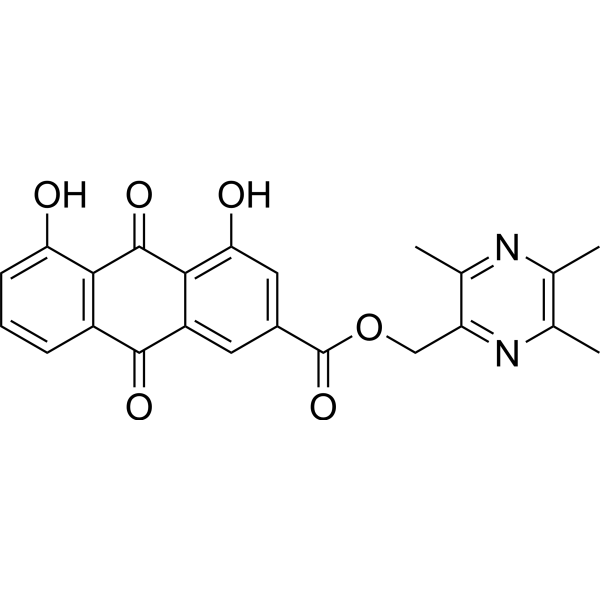
-
- HY-N0793A
-
-
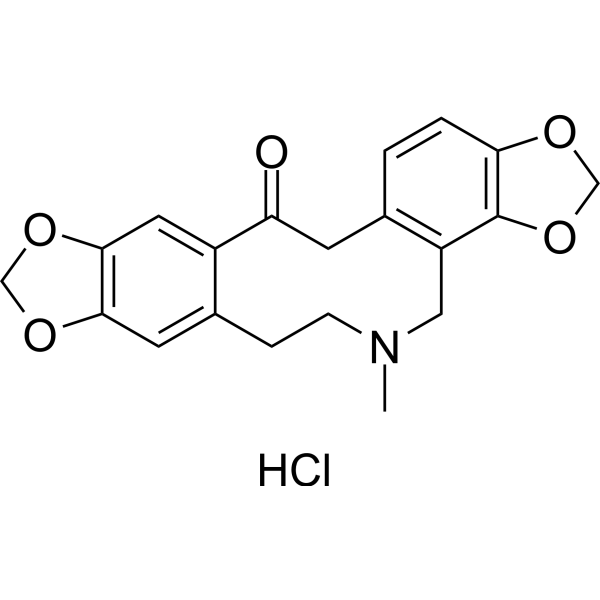
-
- HY-N0793
-
-
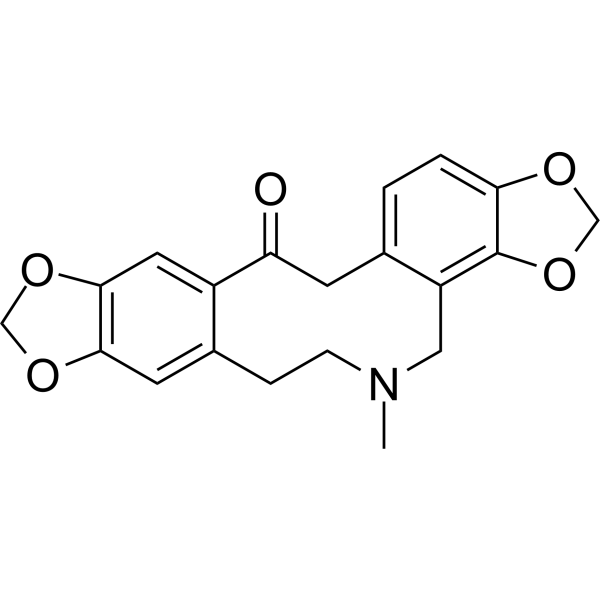
-
- HY-117737A
-
|
|
Raf
Apoptosis
|
Cancer
|
|
RRD-251 is an inhibitor of retinoblastoma tumor suppressor protein (Rb)-Raf-1 interaction, with potent anti-proliferative, anti-angiogenic and anti-tumor activities .
|
-

-
- HY-N0205
-
|
Anemoside B4
|
Others
|
Cancer
|
|
Pulchinenoside C (Anemoside B4) is Pulsatilla koreana Nakai that have many numerous biological effects in vitro, including enhancing hypoglycemic, anti-tumor, neuroprotective and anti-angiogenic activity.
|
-
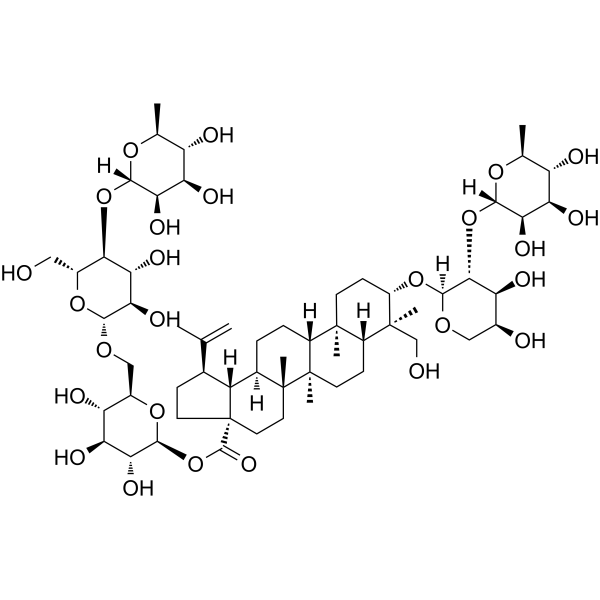
-
- HY-18185
-
|
|
VEGFR
|
Cancer
|
|
JNJ 17029259 is an orally active and selective VEGF-R2 kinase inhibitor. JNJ 17029259 inhibits VEGF-mediated signal transduction. JNJ 17029259 has anti-angiogenic activity .
|
-

-
- HY-125741
-
|
|
Tie
VEGFR
|
Cancer
|
|
GW768505A free base is a potent dual inhibitor of VEGFR2 (KDR) and Tie-2, with a pIC50 of 7.81 for VEGFR2. GW768505A free base has anti-angiogenic activity 。
|
-
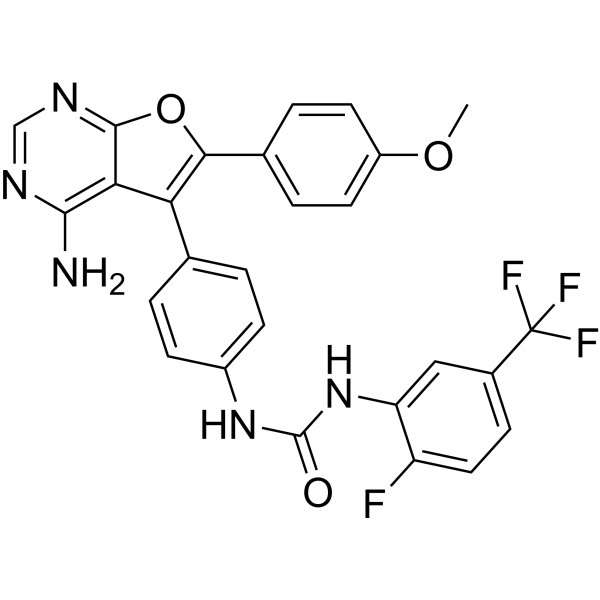
-
- HY-N6258
-
|
|
AMPK
Apoptosis
|
Metabolic Disease
|
|
Kahweol is one of the consituents of the coffee from Coffea Arabica with anti-inflammatory anti-angiogenic, and anti-cancerous activities. Kahweol inhibits adipogenesis and increase glucose uptake by AMP-activated protein kinase (AMPK) activation. Kahweol induces apoptosis.
|
-
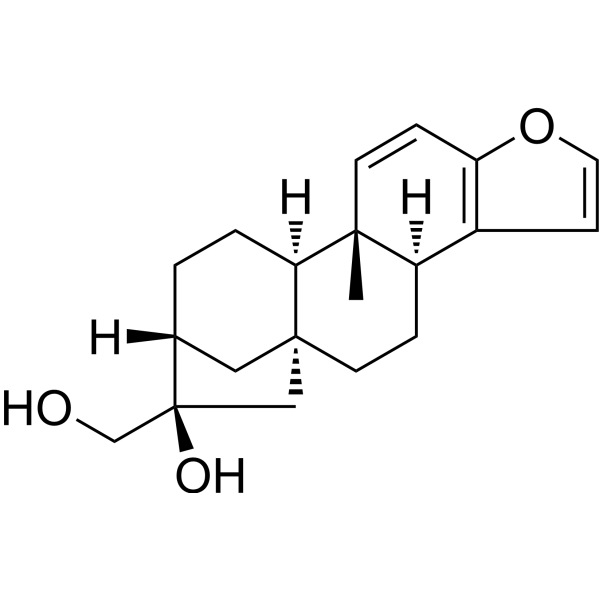
-
- HY-115436
-
|
|
Apoptosis
|
Cancer
|
|
LYG-202, a flavonoid, has potent anti-angiogenic and antitumor activity. LYG-202 inhibits VEGF-stimulated HUVEC migration and tube formation. LYG-202 induces cancer cell apoptosis .
|
-
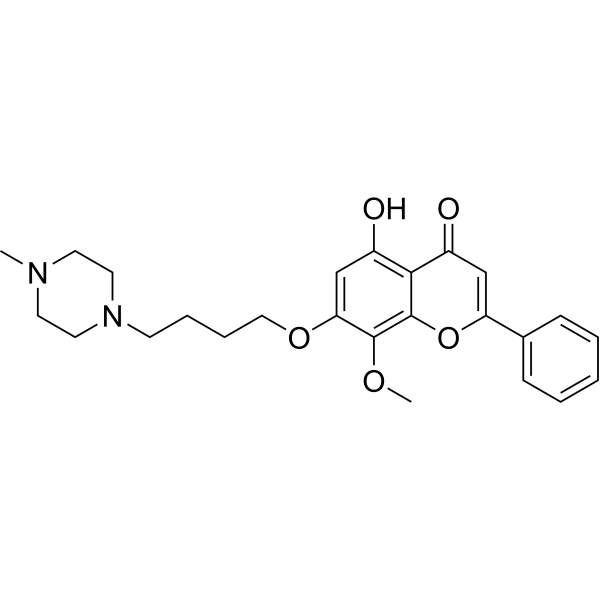
-
- HY-129325
-
|
|
Antibiotic
Bacterial
Apoptosis
Bcl-2 Family
Caspase
|
Infection
Cancer
|
|
Cytochalasin H is a nature product that could be isolated from fungus Phomopsis sp. Cytochalasin H inhibits cell growth and induces apoptosis. Cytochalasin H has anti-angiogenic activity. Cytochalasin H is an antibiotic and has antibacterial activity .
|
-
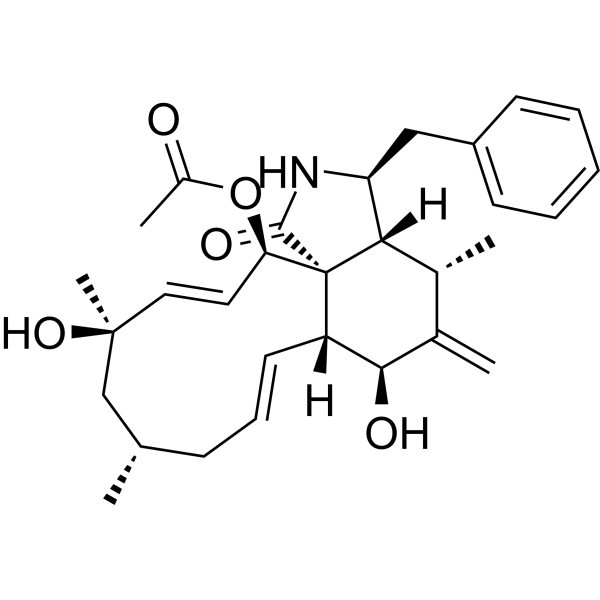
-
- HY-100898
-
|
|
Others
|
Cancer
|
|
OGT 2115 is a potent, cell-permeable and orally active heparanase inhibitor with an IC50 of 0.4 μM. OGT 2115 has anti-angiogenic properties (IC50 of 1 μM). OGT 2115 also inhibits heparan sulfate degradation activity .
|
-
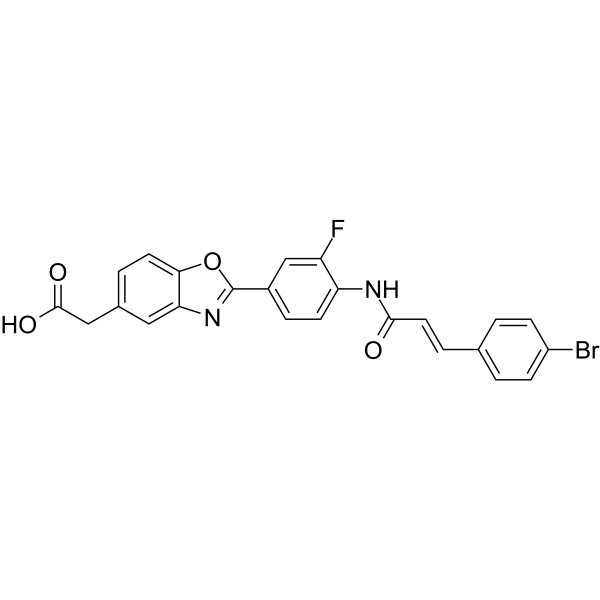
-
- HY-163402
-
|
|
EGFR
Apoptosis
|
Cancer
|
|
EGFR-IN-108 chloride (Compound Ru3S) is an EGFR inhibitor with an IC50 value of 5.8 nM for hEGFR. EGFR-IN-108 chloride induces apoptosis and has anti-proliferative activity against cancer cells. EGFR-IN-108 chloride also has anti-angiogenic effects .
|
-

-
- HY-156019
-
|
|
FGFR
|
Cancer
|
|
FGFR1 inhibitor-10 (Compound 4i) is an FGFR1 inhibitor (IC50: 28 nM). FGFR1 inhibitor-10 inhibits the phosphorylation of FGFR1. FGFR1 inhibitor-10 has anti-angiogenic, anti-invasion activity, and anti-tumor effect .
|
-
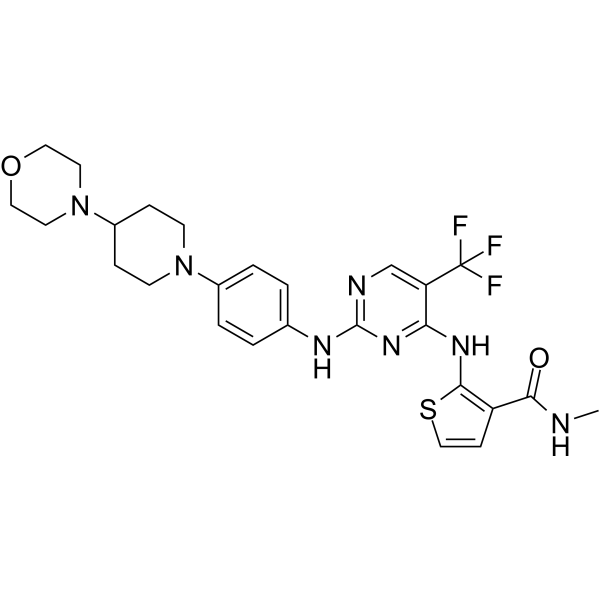
-
- HY-N1067
-
|
|
COX
Acyltransferase
Apoptosis
HSV
CMV
Influenza Virus
|
Infection
Cancer
|
|
Xanthohumol is one of the principal flavonoids isolated from hops, the inhibitor of diacylglycerol acetyltransferase (DGAT), COX-1 and COX-2, and shows anti-cancer and anti-angiogenic activities. Xanthohumol also has antiviral activity against bovine viral diarrhea virus (BVDV), rhinovirus, HSV-1, HSV-2 and cytomegalovirus (CMV).
|
-
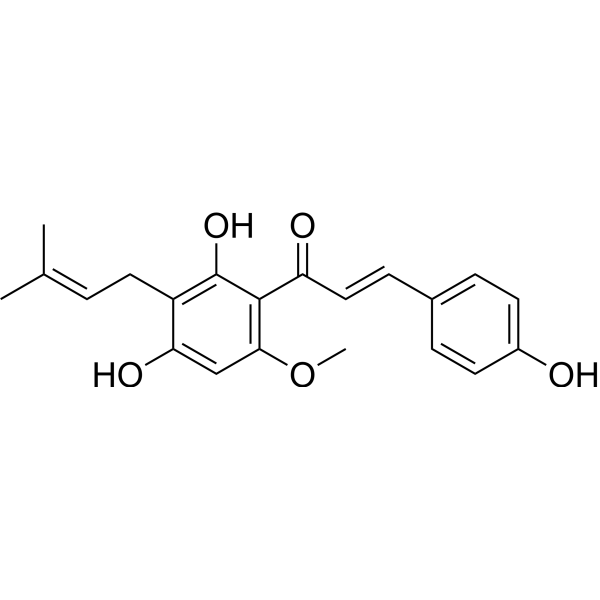
-
- HY-124953
-
|
|
MAP3K
Apoptosis
|
Cancer
|
|
7,3',4'-Trihydroxyisoflavone, a major metabolite of Daidzein, is an ATP-competitive inhibitor of Cot (Tpl2/MAP3K8) and MKK4. 7,3',4'-Trihydroxyisoflavone has anticancer, anti-angiogenic, chemoprotective, and free radical scavenging activities .
|
-
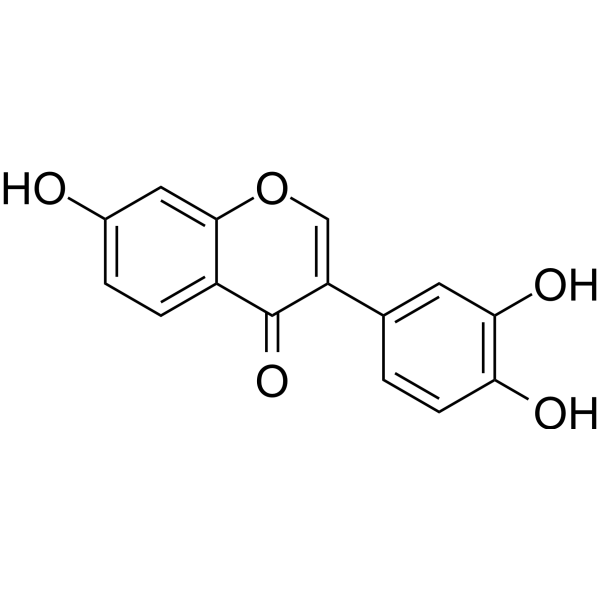
-
- HY-W008859
-
Tetrac
1 Publications Verification
Tetraiodothyroacetic acid; 3,3',5,5'-Tetraiodothyroacetic acid
|
Integrin
Endogenous Metabolite
|
Cancer
|
|
Tetrac (Tetraiodothyroacetic acid), a derivative of L-thyroxine (T4), is a thyrointegrin receptor antagonist. Tetrac blocks the actions of T4 and 3,5,3'-triiodo-L-thyronine (T3) at the cell surface receptor for thyroid hormone on integrin αvβ3. Tetra has anti-angiogenic and anti-tumor activities .
|
-
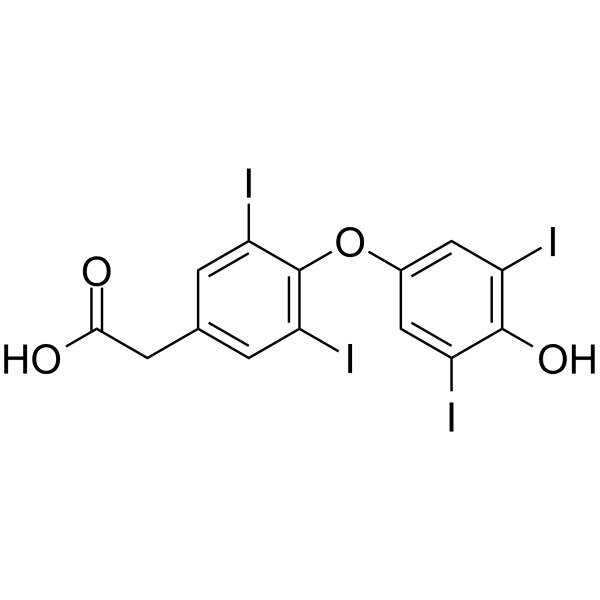
-
- HY-N0923
-
|
(+)-Corydaline; Corydalin
|
Cholinesterase (ChE)
Enterovirus
Opioid Receptor
|
Neurological Disease
|
|
Corydaline ((+)-Corydaline), an isoquinoline alkaloid isolated from Corydalis yanhusuo, is an AChE inhibitor with an IC50 of 226 µM. Corydaline is a μ-opioid receptor (Ki of 1.23 µM) agonist and inhibits enterovirus 71 (EV71) replication (IC50 of 25.23 µM). Corydaline has anti-angiogenic, anti-allergic and gastric-emptying and antinociceptive activities .
|
-
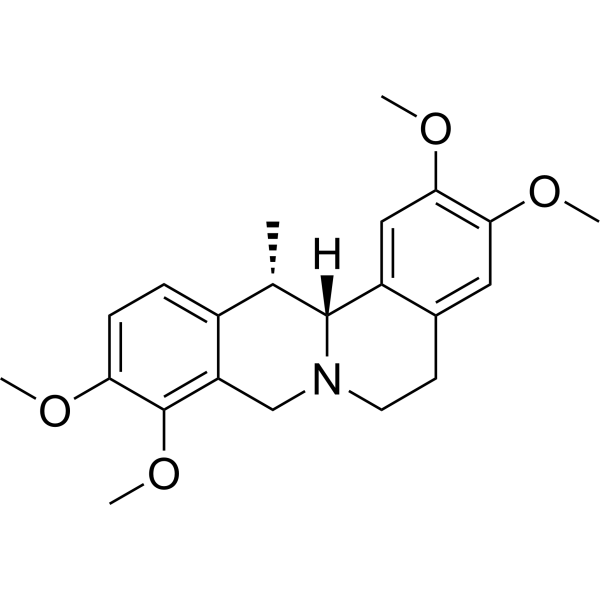
-
- HY-19827
-
|
(+)-Aeroplysinin-1
|
Bacterial
HIV
Apoptosis
|
Infection
Cancer
|
|
Aeroplysinin 1 ((+)-Aeroplysinin-1), a secondary metabolite isolated from marine sponges, shows potent antibiotic effects on Gram-positive bacteria and exerts antiviral activity against HIV-1 (IC50=14.6 μM). Aeroplysinin 1 has anti-inflammatory, anti-angiogenic and anti-tumor activities. Aeroplysinin 1 induces apoptosis in endothelial cells .
|
-
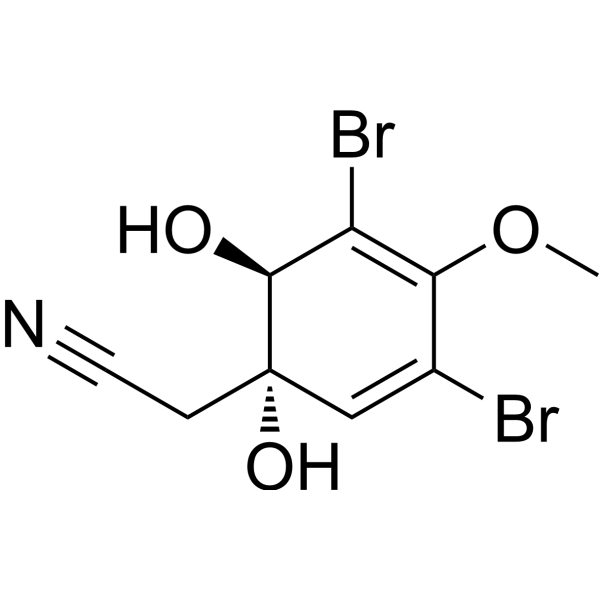
-
- HY-13737
-
R1530
1 Publications Verification
|
VEGFR
FGFR
Apoptosis
|
Cancer
|
|
R1530 is a highly potent, orally active, dual-acting mitosis/angiogenesis inhibitor, with anti-tumor and anti-angiogenic activities. R1530 is a multikinase inhibitor which binds to 31 kinases with Kd values of <500 nM. R1530 inhibits VGFR2 and FGFR1 with IC50 of 10 nM and 28 nM, respectively. R1530 triggers apoptosis (mitotic catastrophe) or senescence .
|
-
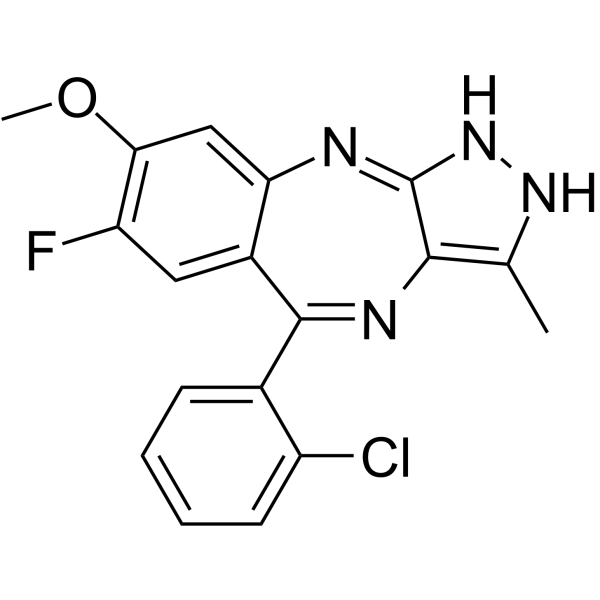
-
- HY-10220
-
|
|
PI3K
Apoptosis
|
Cancer
|
|
SF1126 is a relevant pan and dual first-in-class PI3K/BRD4 inhibitor, has antitumor and anti-angiogenic activity. SF1126 is an RGDS-conjugated LY294002 proagent, which is designed to exhibit increased solubility and bind to specific integrins within the tumor compartment. SF1126 induces cell apoptosis .
|
-
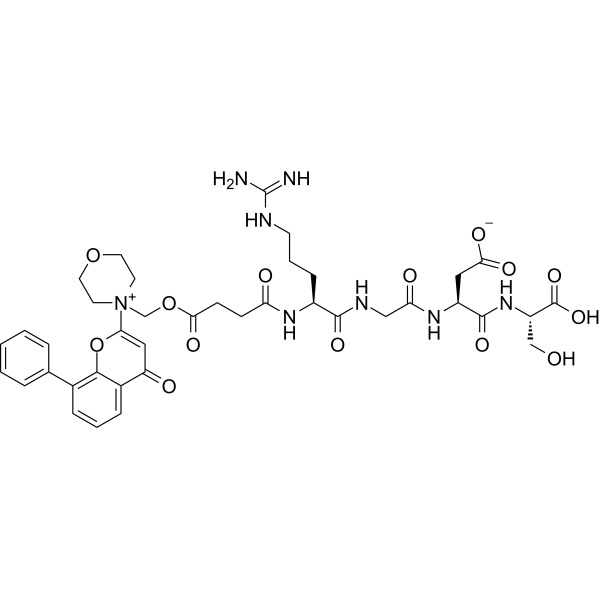
-
- HY-107818
-
|
|
NF-κB
|
Cardiovascular Disease
Inflammation/Immunology
|
|
4-Hydroxychalcone is a chalcone metabolite with anti-angiogenic and anti-inflammatory activities. 4-Hydroxychalcone suppresses angiogenesis by suppression of growth factor pathway with no signs of cytotoxicity . 4-Hydroxychalcone inhibits TNF-α induced NF-κB pathway activation and activates BMP signaling, reduces resistant hypertension (RH) by attenuating hyperaldosteronism and renal injury in mice .
|
-
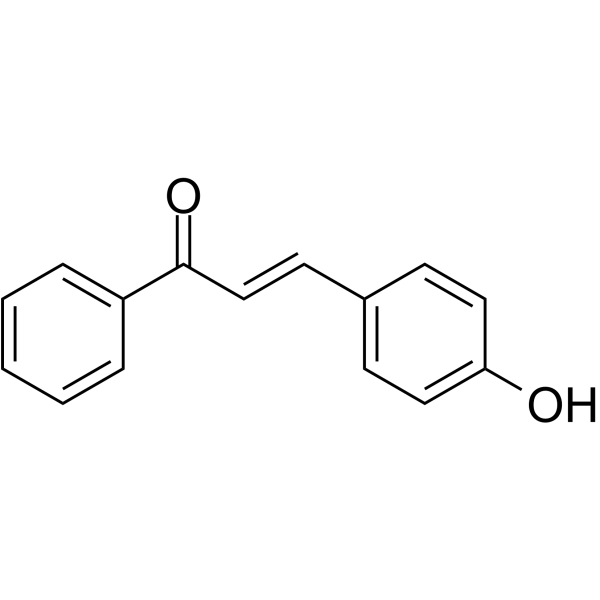
-
- HY-N2533
-
|
Cyanidin-3-O-sambubioside chloride
|
Influenza Virus
Angiotensin-converting Enzyme (ACE)
|
Infection
Inflammation/Immunology
Cancer
|
|
Cyanidin 3-sambubioside chloride (Cyanidin-3-O-sambubioside chloride), a major anthocyanin, a natural colorant, and is a potent NO inhibitor. Cyanidin 3-sambubioside chloride is a H274Y mutation inhibitor, and inhibits influenza neuraminidase activity with an IC50 of 72 μM. Cyanidin 3-sambubioside chloride inhibits angiotensin-converting enzyme (ACE) activity and has antioxidant, anti-angiogenic and antiviral properties .
|
-
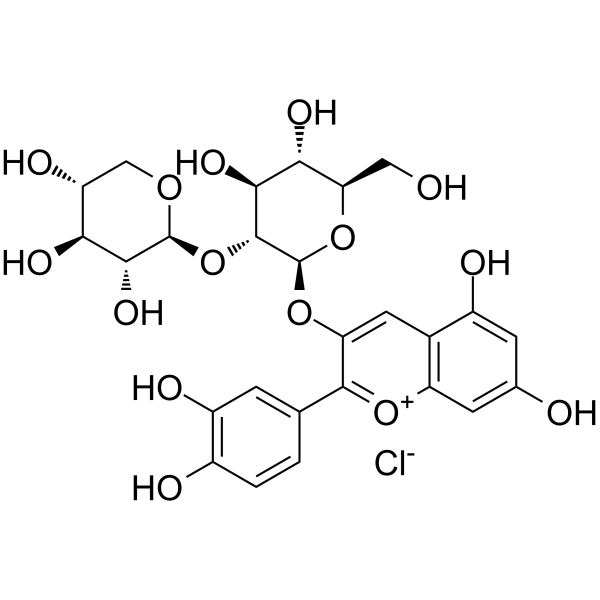
-
- HY-P99386
-
|
MNRP-1685A
|
Complement System
|
Cancer
|
|
Vesencumab (MNRP-1685A) is IG1 antibody against neuropilin-1 (NRP-1). Vesencumab binds to NRP-1 and prevents the subsequent coupling of NRP-1 to VEGFR-2. Vesencumab has anti-angiogenic and anti-neoplastic activities. Vesencumab can be used in the research of metastatic solid tumors, including ovarian cancer .
|
-

-
- HY-161284
-
|
|
MMP
|
Cancer
|
|
MMP-9/10-IN-1 (Compound 6b) is a potent dual MMP-9/10 Inhibotor with IC50s of 0.076 and 0.139 μM against NSCLC and A549 cells, respectively. MMP-9/10-IN-1 has anti-invasive and anti-angiogenic activities when in combination with Sorafenib (HY-10201) .
|
-
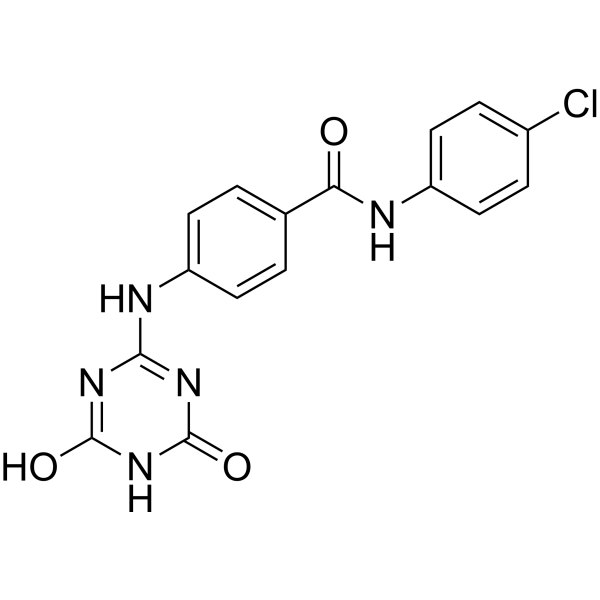
-
- HY-B0965A
-
|
|
|
|
|
Thioridazine, an antagonist of the dopamine receptor D2 family proteins, exhibits potent anti-psychotic and anti-anxiety activities. Thioridazine is also a potent inhibitor of PI3K-Akt-mTOR signaling pathways with anti-angiogenic effect. Thioridazine shows antiproliferative and apoptosis induction effects in various types of cancer cells, with specificity on targeting cancer stem cells (CSCs) .
|
-

-
- HY-B0965
-
|
|
Dopamine Receptor
Apoptosis
5-HT Receptor
Autophagy
Bacterial
|
Infection
Neurological Disease
Cancer
|
|
Thioridazine hydrochloride, an orally active antagonist of the dopamine receptor D2 family proteins, exhibits potent anti-psychotic and anti-anxiety activities. Thioridazine hydrochloride is also a potent inhibitor of PI3K-Akt-mTOR signaling pathways with anti-angiogenic effect. Thioridazine hydrochloride shows antiproliferative and apoptosis induction effects in various types of cancer cells, with specificity on targeting cancer stem cells (CSCs) .
|
-

-
- HY-N6924
-
|
|
HIV
|
Infection
Metabolic Disease
|
|
Zingibroside R1 is dammaranae-type triterpenoid saponin, isolated from rhizomes, taproots, and lateral roots of Panax japonicas C. A. Meyer, shows excellent anti-tumor effects as well as anti-angiogenic activity .
Zingibroside R1 possesses some anti-HIV-1 activity.
Zingibroside R1 has inhibitory effects on the 2-deoxy-D-glucose (2-DG) uptake by EAT cells (IC50=91.3 μM) .
|
-

-
- HY-N0615
-
|
Sanchinoside R1; Sanqi glucoside R1
|
Amyloid-β
Apoptosis
|
Others
|
|
Notoginsenoside R1 (Sanchinoside R1), a saponin, is isolated from P. notoginseng. Notoginsenoside R1 exhibits anti-oxidation, anti-inflammatory, anti-angiogenic, and anti-apoptosis activities. Notoginsenoside R1 provides cardioprotection against ischemia/reperfusion (I/R) injury. Notoginsenoside R1 also provides neuroprotection in H2O2-induced oxidative damage in PC12 cells .
|
-
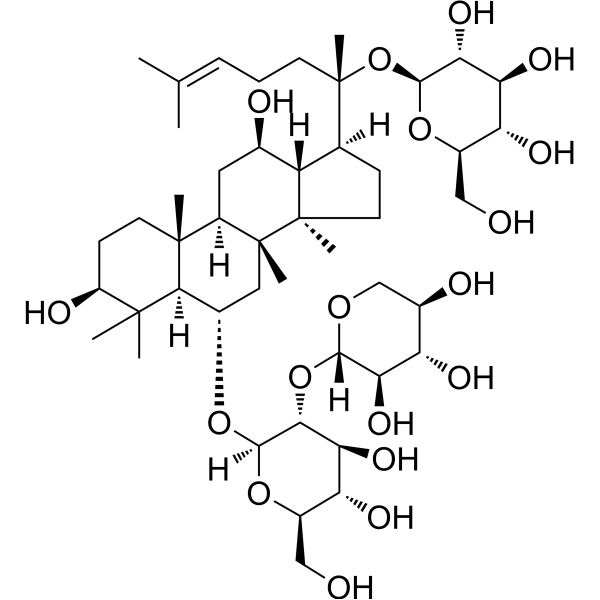
-
- HY-N0234
-
|
7-O-Methylbavachin; Bavachinin A
|
Amyloid-β
PPAR
HIF/HIF Prolyl-Hydroxylase
|
Inflammation/Immunology
|
|
Bavachinin is agonist of pan-peroxisome proliferator-activated receptor (PPAR), with the IC50 value of 21.043 μM, 12.819 μM, and 0.622 μM to PPAR-α, RRAR-β/δ, and PPAR-γ, respectively. Bavachinin is an inhibitor of HIF-1α. Bavachinin exhibits antitumor activity against non-small cell lung cancer by targeting RRAR-γ. Bavachinin is a natural compound with anti-inflammatory and anti-angiogenic activities. Bavachinin has orally bioactivity. .
|
-
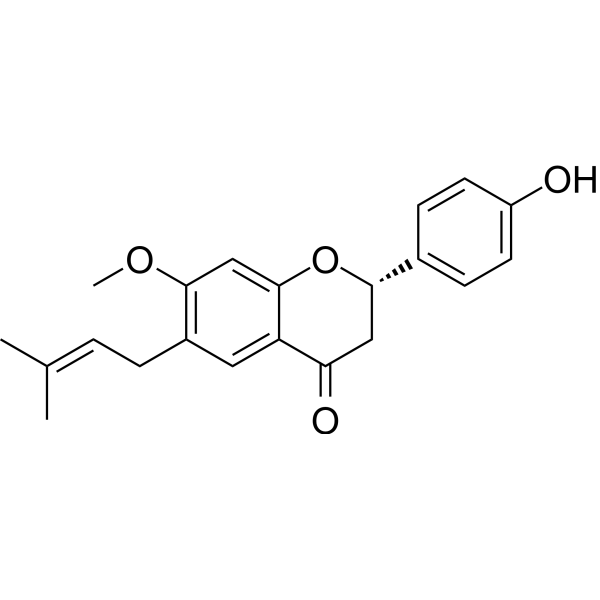
-
- HY-108933
-
|
|
VEGFR
FGFR
|
Cancer
|
|
JK-P3 is a potent and pan VEGFR2 inhibitor, with IC50s of 7.83 μM, 27 μM and 5.18 μM for VEGFR2, FGFR1 and FGFR3, respectively. JK-P3 can inhibit VEGF-A-stimulated VEGFR2 activation and intracellular signalling, also inhibits endothelial monolayer wound closure and angiogenesis, as well as fibroblast growth factor receptor kinase activity in vitro. JK-P3 has anti-angiogenic activity .
|
-

-
- HY-B0965AS
-
|
|
Dopamine Receptor
Apoptosis
5-HT Receptor
Autophagy
Bacterial
|
Neurological Disease
|
|
Thioridazine-d3 (hydrochloride) is the deuterium labeled Thioridazine. Thioridazine, an antagonist of the dopamine receptor D2 family proteins, exhibits potent anti-psychotic and anti-anxiety activities. Thioridazine is also a potent inhibitor of PI3K-Akt-mTOR signaling pathways with anti-angiogenic effect. Thioridazine shows antiproliferative and apoptosis induction effects in various types of cancer cells, with specificity on targeting cancer stem cells (CSCs)[1][2][3][4].
|
-

-
- HY-101849
-
|
|
GLUT
TNF Receptor
Apoptosis
|
Cardiovascular Disease
Cancer
|
|
Fasentin, a potent glucose uptake inhibitor, inhibits GLUT-1/GLUT-4 transporters. Fasentin preferentially inhibits GLUT4 (IC50=68 μM) over GLUT1. Fasentin is a death receptor stimuli (FAS) sensitizer and sensitizes cells to FAS-induced cell death. Fasentin is also a tumor necrosis factor (TNF) apoptosis-inducing ligand sensitizer. Fasentin blocks glucose uptake in cancer cell lines and has anti-angiogenic activity .
|
-

-
- HY-400684
-
|
|
Others
|
Cancer
|
|
Tubulysin A intermediate-1 is an intermediate in the synthesis of the cytotoxic peptide Tubulysin A (HY-15995). Tubulysin A (TubA) is an antibiotic, anti-microtubule toxins, and apoptosis inducer isolated from myxobacteria. Tubulysin A has anti-angiogenic, anti-microtubule, anti-mitotic, and anti-proliferative activities. Tubulysin A arrests cells in the G2/M phase, effectively inhibits tubulin polymerization, and induces depolymerization of detached microtubules. Tubulysin A acts as an ADC cytotoxin (ADC Cytotoxin) to synthesize ADC .
|
-
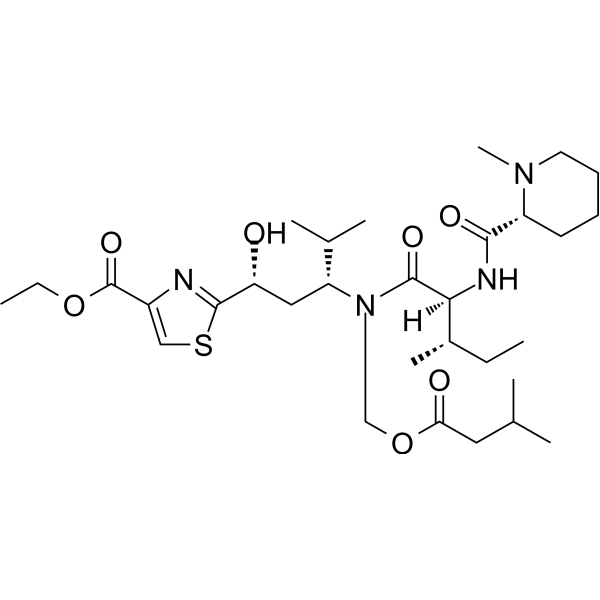
-
- HY-N4226
-
|
|
AP-1
|
Inflammation/Immunology
Cancer
|
|
1-Methyl-6-oxo-1,6-dihydropyridine-3-carboxylic acid is from Cordyceps bassiana, which is one of Cordyceps species with anti-oxidative, anti-cancer, anti-inflammatory, anti-diabetic, anti-obesity, anti-angiogenic, and anti-nociceptive activities. 1-Methyl-6-oxo-1,6-dihydropyridine-3-carboxylic acid targets to block AP-1-mediated luciferase activity, implying it has an anti-inflammatory function .
|
-

-
- HY-B0965R
-
|
|
Dopamine Receptor
Apoptosis
5-HT Receptor
Autophagy
Bacterial
|
Infection
Neurological Disease
Cancer
|
|
Thioridazine (hydrochloride) (Standard) is the analytical standard of Thioridazine (hydrochloride). This product is intended for research and analytical applications. Thioridazine hydrochloride, an orally active antagonist of the dopamine receptor D2 family proteins, exhibits potent anti-psychotic and anti-anxiety activities. Thioridazine hydrochloride is also a potent inhibitor of PI3K-Akt-mTOR signaling pathways with anti-angiogenic effect. Thioridazine hydrochloride shows antiproliferative and apoptosis induction effects in various types of cancer cells, with specificity on targeting cancer stem cells (CSCs) .
|
-

-
- HY-W016412
-
-
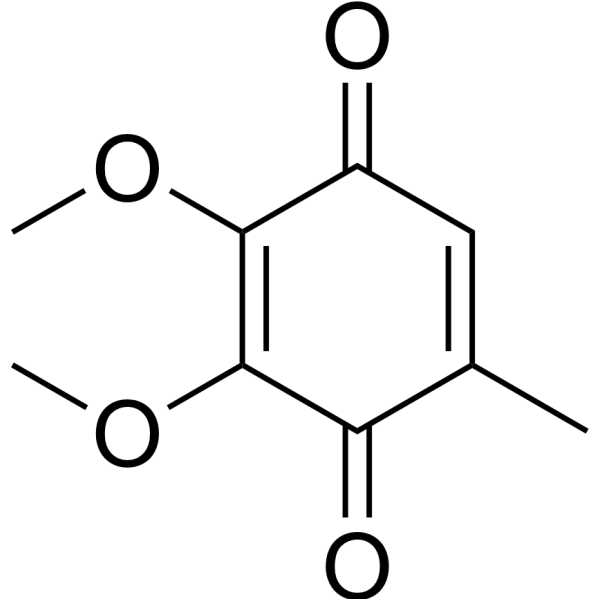
-
- HY-136065
-
|
|
PTEN
Phosphatase
Parasite
Apoptosis
|
Infection
Metabolic Disease
Inflammation/Immunology
Cancer
|
|
bpV(phen), a insulin-mimetic agent, is a potent protein tyrosine phosphatase (PTP) and PTEN inhibitor with IC50s of 38 nM, 343 nM and 920 nM for PTEN, PTP-β and PTP-1B, respectively. bpV(phen) inhibits proliferation of the protozoan parasite Leishmania in vitro. bpV(phen) strongly induces the secretion of a large number of chemokines and pro-inflammatory cytokines, and it activates a Th1-type pathway (IL-12, IFNγ). bpV(phen) can also induce cell apoptosis, and has anti-angiogenic and anti-tumor activity .
|
-

-
- HY-122818
-
|
|
PTEN
Phosphatase
Parasite
Apoptosis
|
Infection
Metabolic Disease
Inflammation/Immunology
Cancer
|
|
bpV(phen) trihydrate, a insulin-mimetic agent, is a potent protein tyrosine phosphatase (PTP) and PTEN inhibitor with IC50s of 38 nM, 343 nM and 920 nM for PTEN, PTP-β and PTP-1B, respectively. bpV(phen) trihydrate inhibits proliferation of the protozoan parasite Leishmania in vitro. bpV(phen) trihydrate strongly induces the secretion of a large number of chemokines and pro-inflammatory cytokines, and it activates a Th1-type pathway (IL-12, IFNγ). bpV(phen) trihydrate can also induce cell apoptosis, and has anti-angiogenic and anti-tumor activity .
|
-

-
- HY-N9396
-
-
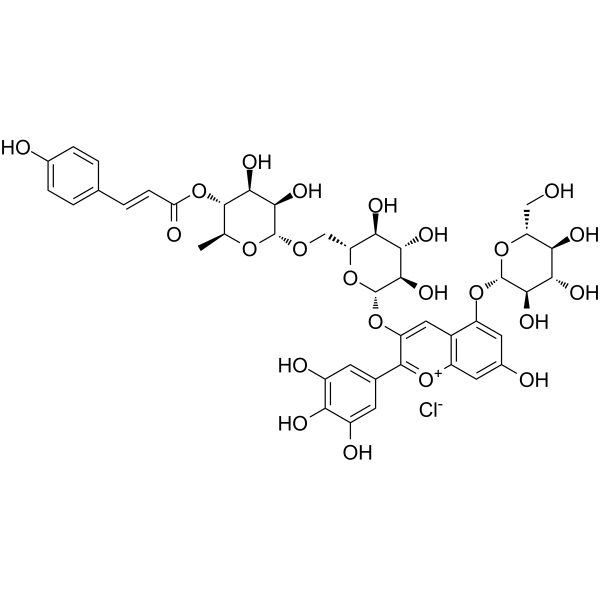
-
- HY-N4094
-
-
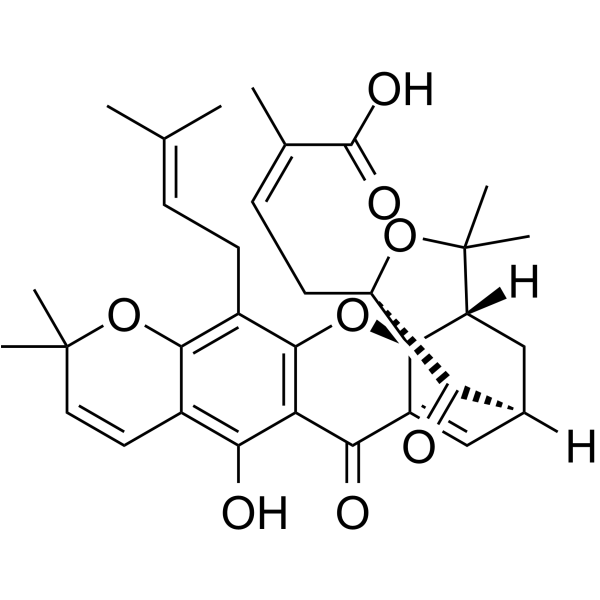
-
- HY-121382
-
-
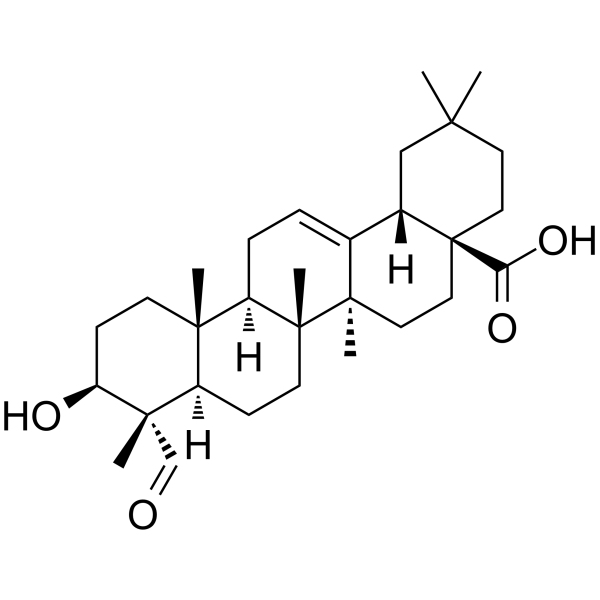
-
- HY-12289
-
|
VS-6063; PF-04554878
|
FAK
|
Cancer
|
|
Defactinib (VS-6063; PF-04554878) is a novel FAK inhibitor with potential antiangiogenic and antineoplastic activities.
|
-
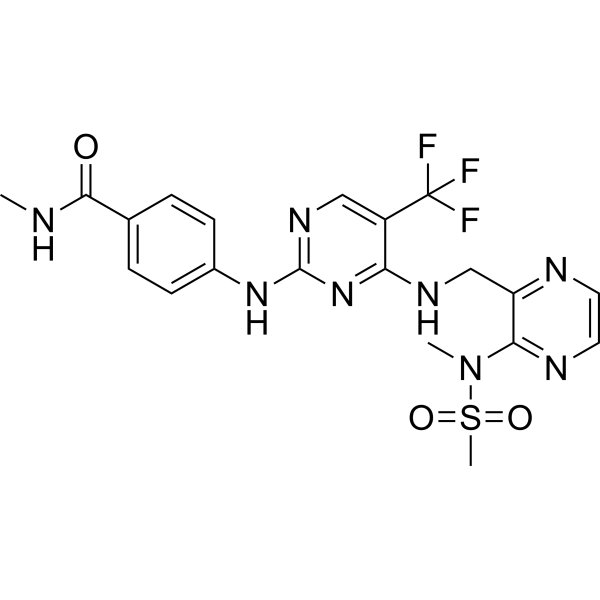
-
- HY-133571
-
|
AHGDM
|
HSP
ADC Cytotoxin
|
Cancer
|
|
Aminohexylgeldanamycin (AHGDM), a Geldanamycin derivative, is a potent HSP90 inhibitor. Aminohexylgeldanamycin shows antiangiogenic and antitumor activities .
|
-
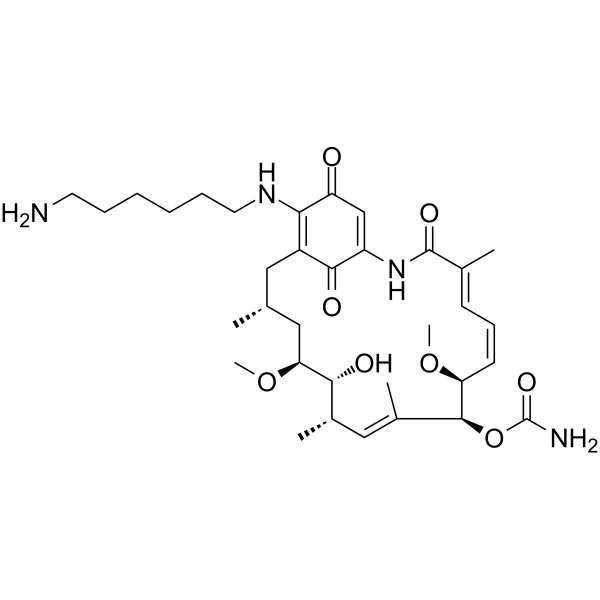
-
- HY-133571A
-
|
AHGDM hydrochloride
|
HSP
ADC Cytotoxin
|
Cancer
|
|
Aminohexylgeldanamycin (AHGDM) hydrochloride, a Geldanamycin derivative, is a potent HSP90 inhibitor. Aminohexylgeldanamycin hydrochloride shows antiangiogenic and antitumor activities .
|
-
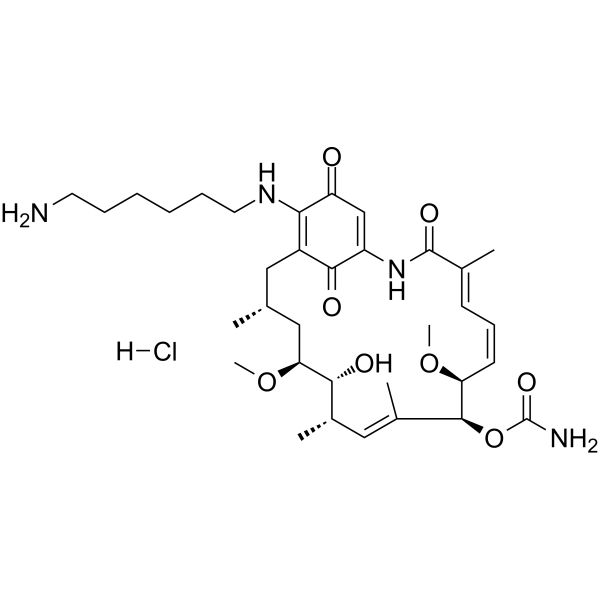
-
- HY-17601
-
|
RPT835
|
FGFR
Apoptosis
|
Cardiovascular Disease
Cancer
|
|
Alofanib (RPT835) is a potent and selective allosteric inhibitor of fibroblast growth factor receptor 2 (FGFR2). Anticancer and antiangiogenic activity .
|
-
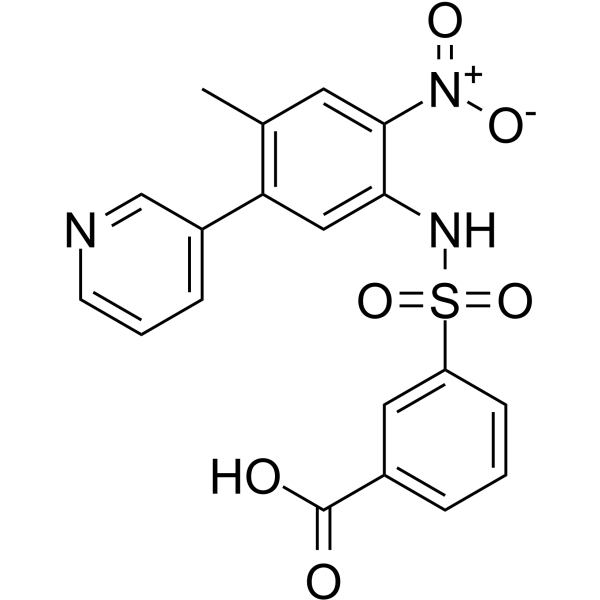
-
- HY-12289S
-
|
VS-6063-d6; PF-04554878-d6
|
FAK
Isotope-Labeled Compounds
|
Cancer
|
|
Defactinib-d6 is a deuterium labeled Defactinib (HY-12289). Defactinib is a novel FAK inhibitor with potential antiangiogenic and antineoplastic activities .
|
-
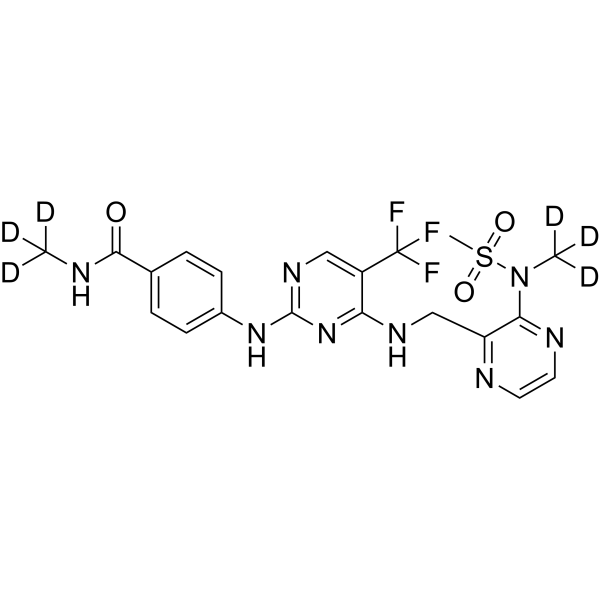
- HY-N5074
-
|
|
Apoptosis
|
Cancer
|
|
Terrestrosin D, a steroidal saponin from Tribulus terrestris L., induces cell cycle arrest and cancer cells apoptosis. Terrestrosin D has antiangiogenic activities .
|
-
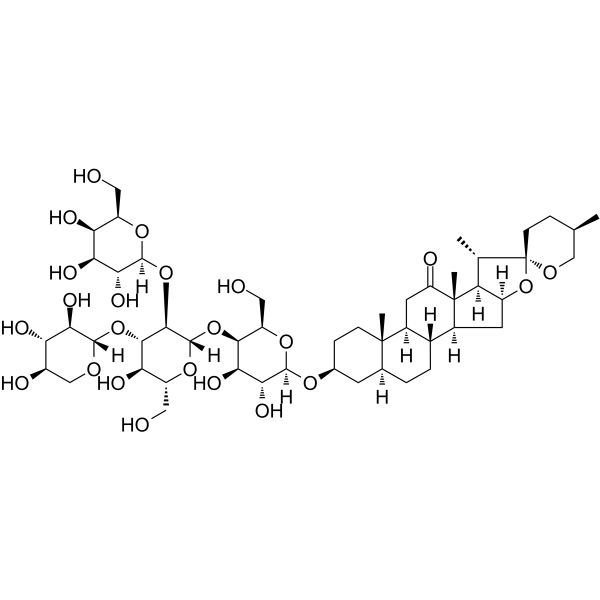
- HY-16958
-
|
|
|
|
|
PD 404182 is a potent and competitive inhibitor of human dimethylarginine dimethylaminohydrolase 1 (DDAH1), with an IC50 of 9 μM. PD 404182 exhibits antiangiogenic and antiviral activity in vitro .
|
-
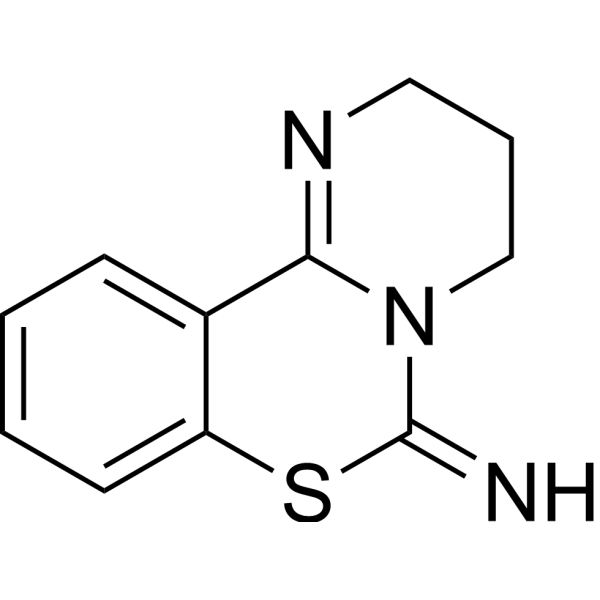
- HY-10454
-
|
CEP-18770
|
Proteasome
NF-κB
Apoptosis
|
Cancer
|
|
Delanzomib (CEP-18770) is a potent and orally active chymotrypsin-like activity of the proteasome inhibitor with an IC50 of 3.8 nM. Delanzomib inhibits NF-κB activity, induces cancer cell apoptotic, and has strong antiangiogenic and anti-cancer activities .
|
-
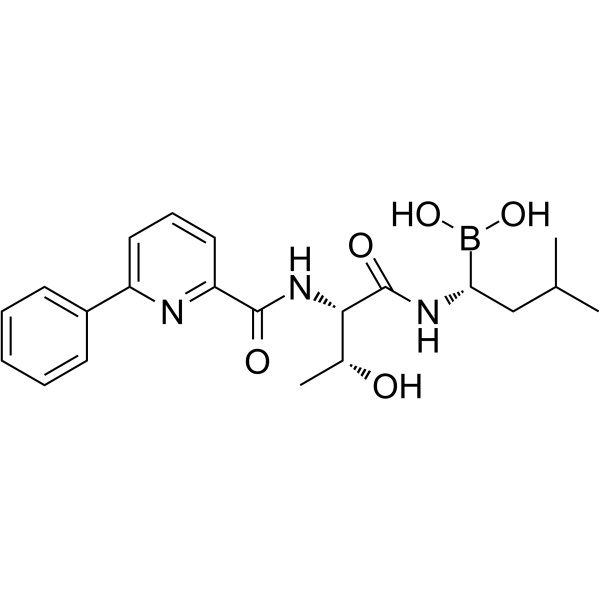
- HY-N2732
-
|
6-Prenyl-4',5,7-trihydroxyflavone; 6-C-Prenylapigenin
|
Others
|
Cancer
|
|
6-Prenylapigenin is a biologically active flavonoid with anti-tumor activity and antiangiogenic properties. 6-Prenylapigenin exerts cytotoxicity against cancer cells, such as leukemia and solid cancer cells .
|
-
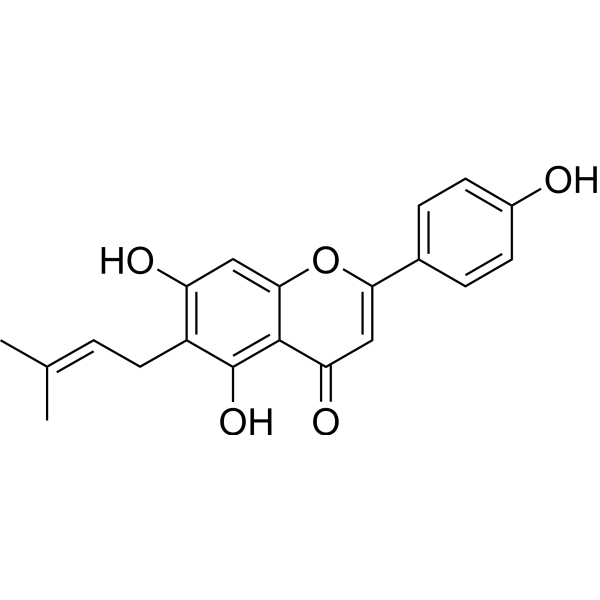
- HY-P1415
-
-
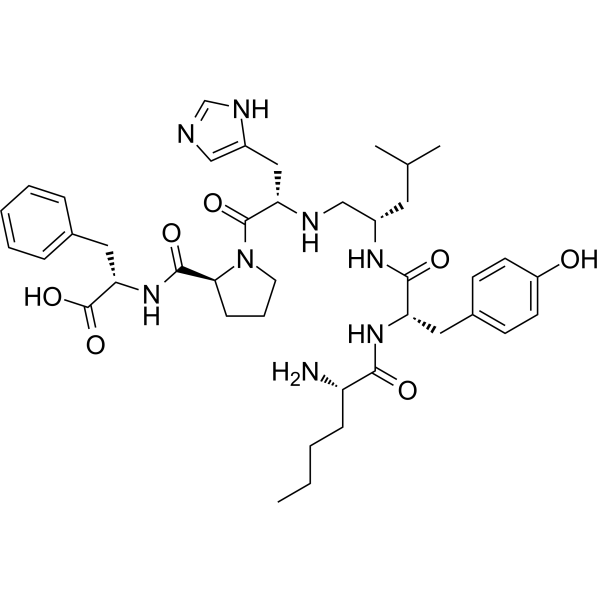
- HY-N8178
-
|
|
Others
|
Cardiovascular Disease
|
|
(R)-(4′-Hydroxy)-5,7-dihydroxy-4-chromanone, a homoisoflavonoid, has antiangiogenic activity against human retinal microvascular endothelial cells .
|
-
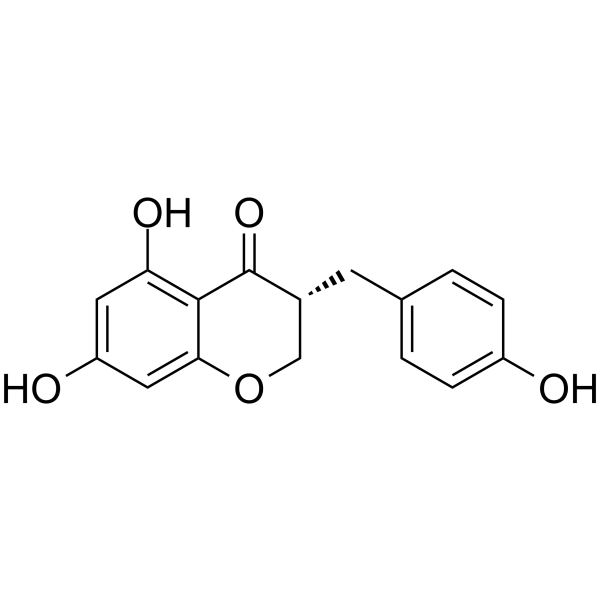
- HY-15198
-
|
|
Raf
PDGFR
FLT3
c-Kit
|
Cancer
|
|
KG5 is an orally active dual PDGFRβ and B-Raf allosteric inhibitor. KG5 also inhibits Flt3, KIT and c-Raf. KG5 has anticancer, antiangiogenic activities .
|
-
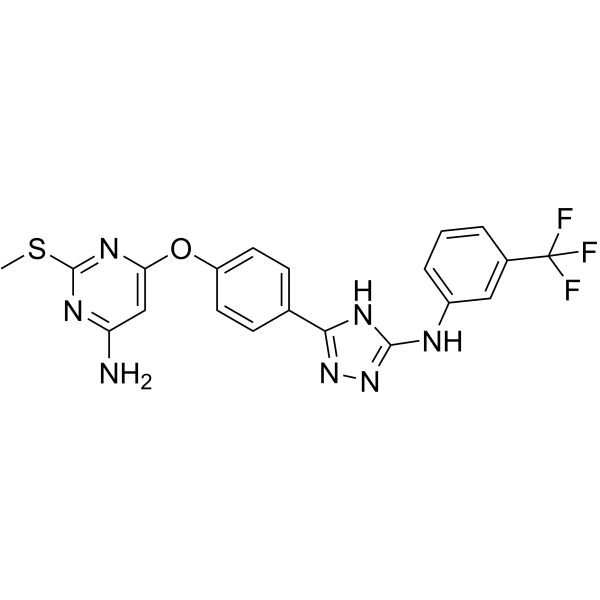
- HY-P1415A
-
-
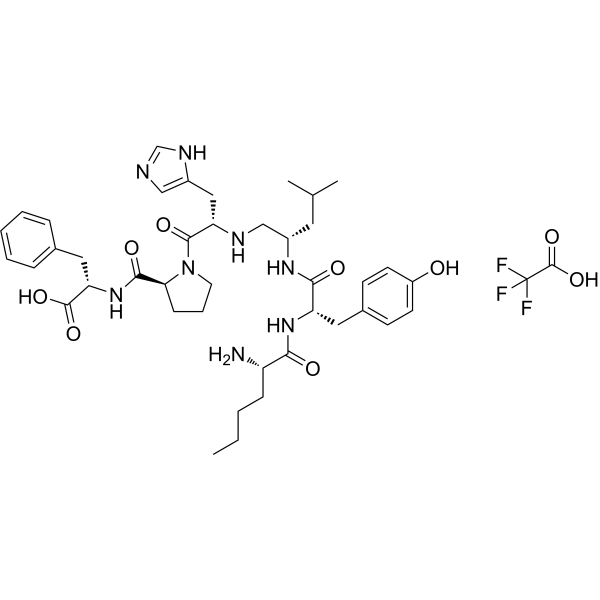
- HY-N0003
-
|
NSC 293100
|
Akt
Autophagy
HCV
ERK
|
Cancer
|
|
Honokiol is a bioactive, biphenolic phytochemical that possesses potent antioxidative, anti-inflammatory, antiangiogenic, and anticancer activities by targeting a variety of signaling molecules. It inhibits the activation of Akt. Honokiol can readily cross the blood brain barrier .
|
-

- HY-N8342
-
|
|
VEGFR
|
Inflammation/Immunology
Cancer
|
|
Rhamnazin is an orally active inhibitor of VEGFR2 signaling with an IC50 of 4.68 μM against VEGFR2 kinase. Rhamnazin shows potent antiangiogenic activity and antitumor efficacy . Rhamnazin shows antioxidant and anti-inflammatory properties .
|
-
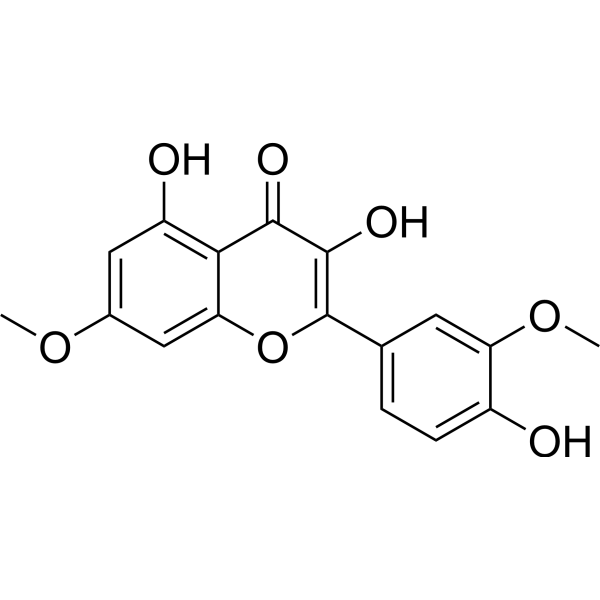
- HY-108486
-
|
|
Bacterial
Antibiotic
|
Infection
|
|
Herbimycin A, an ansamycin antibiotic, acts as a Src family kinase inhibitor. Herbimycin A binds to the SH domain and inhibits the activity of p60 v-src and p210 BCR-ABL Herbimycin A inhibits Hsp90 and impairs recovery from heat shock. Herbimycin A exhibits antiangiogenic activity in endothelial cells in vitro.
|
-
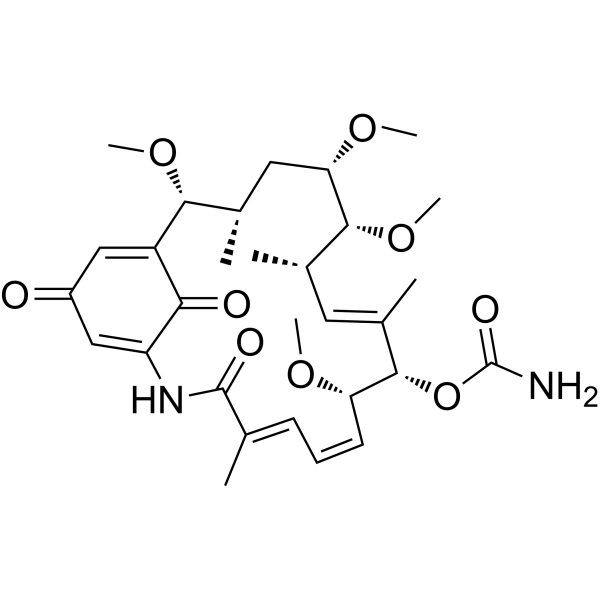
- HY-100450
-
|
|
|
|
|
BML-111, a lipoxin A4 analog, is a lipoxin A4 receptor agonist. BML-111 represses the activity of angiotensin converting enzyme (ACE) and increases the activity of angiotensinconverting enzyme 2 (ACE2). BML-111 has antiangiogenic, antitumor and anti-inflammatory properties .
|
-
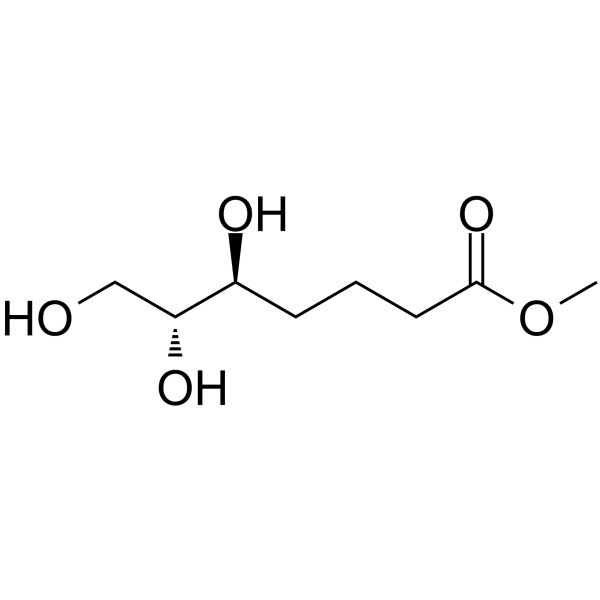
- HY-144818
-
|
|
Apoptosis
Microtubule/Tubulin
|
Cancer
|
|
Tubulin inhibitor 23 is a potent Tubulin inhibitor with an IC50 of 4.8 µM. Tubulin inhibitor 23 induces cell apoptosis. Tubulin inhibitor 23 shows antiangiogenic activity in a dose-dependent manner. Tubulin inhibitor 23 has the potential for the research of leukaemia .
|
-

- HY-P99768
-
|
TTAC-0001
|
VEGFR
|
Cancer
|
|
Olinvacimab (TTAC-0001) is a fully human anti-VEGFR2 monoclonal antibody. Olinvacimab inhibits VEGF binds to KDR with a Kd value of 0.23 nM. Olinvacimab has antiangiogenic activity. Olinvacimab can be used for the research of recurrent glioblastoma and breast cancer .
|
-
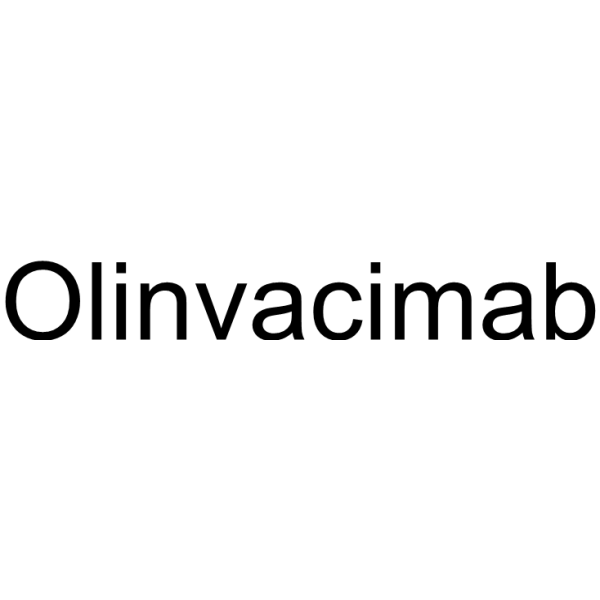
- HY-114653
-
|
|
Casein Kinase
SRPK
|
Cancer
|
|
SRPIN803 is a potent CK2 and SRPK1 dual inhibitor, with IC50s of 203 nM and 2.4 μM, respectively. SRPIN803 exhibits antiangiogenic activity. SRPIN803 can be used for the research of age-related macular degeneration .
|
-
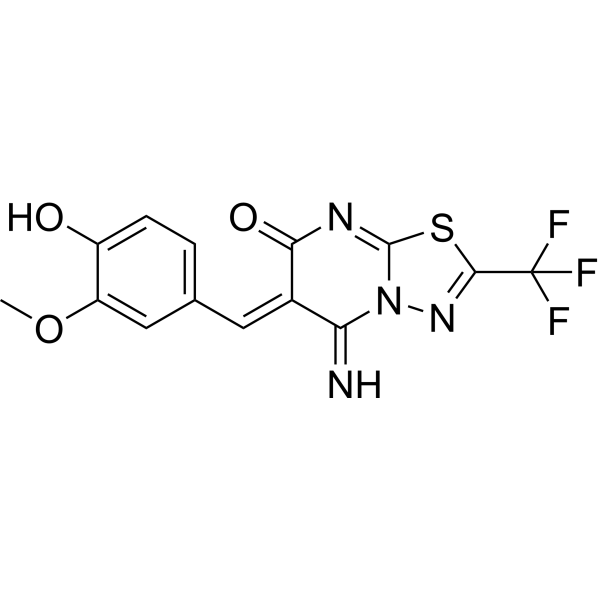
- HY-W011434
-
|
TGIC; Teroxirone
|
MDM-2/p53
Apoptosis
|
Inflammation/Immunology
Cancer
|
|
Triglycidyl isocyanurate (TGIC; Teroxirone) is a triazene triepoxide with antiangiogenic and antineoplastic activities. Triglycidyl isocyanurate inhibits the growth of non-small-cell-lung cancer cells via p53 activation. Triglycidyl isocyanurate induces cell apoptosis. Triglycidyl isocyanurate can be used for cancer research .
|
-
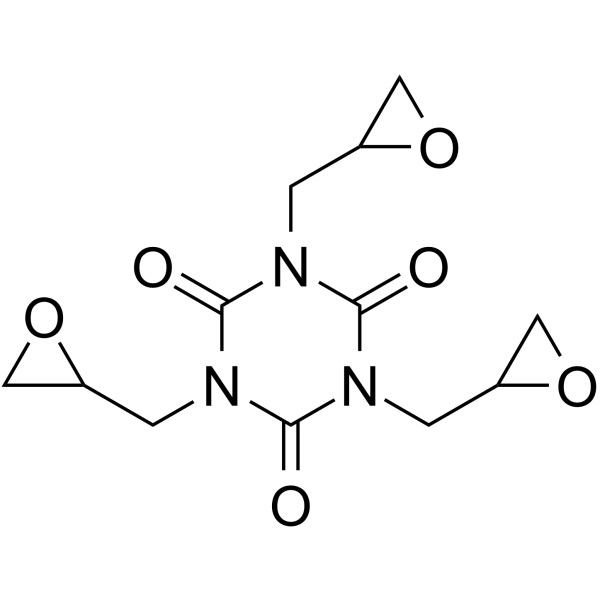
- HY-16196
-
|
IRC-110160
|
Microtubule/Tubulin
HIF/HIF Prolyl-Hydroxylase
STAT
|
Cancer
|
|
ENMD-1198 (IRC-110160), an orally active microtubule destabilizing agent, is a 2-methoxyestradiol analogue with antiproliferative and antiangiogenic activity. ENMD-1198 is suitable for inhibiting HIF-1alpha and STAT3 in human HCC cells and leads to reduced tumor growth and vascularization.
|
-
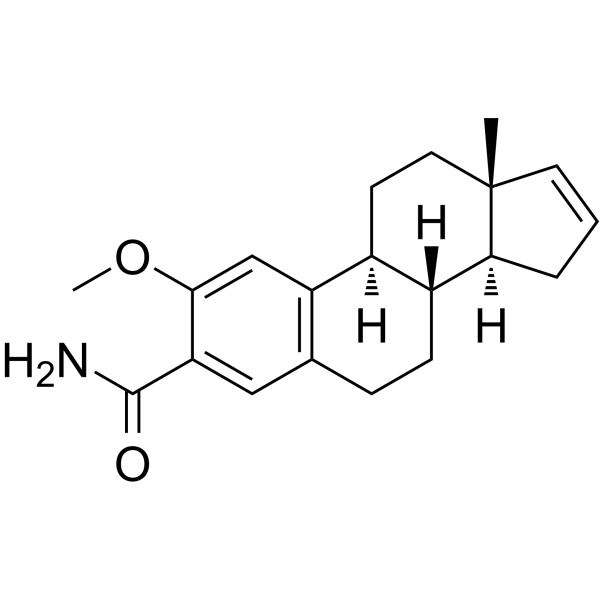
- HY-146420
-
|
|
HSP
|
Cardiovascular Disease
Cancer
|
|
GRP78-IN-2 (Compound FL5) is a GRP78 (Glucose Regulated Protein 78 kDa) inhibitor. GRP78-IN-2 preferentially targeting cell surface GRP78 and shows potent antiangiogenic and anticancer activities without affecting other normal cells .
|
-
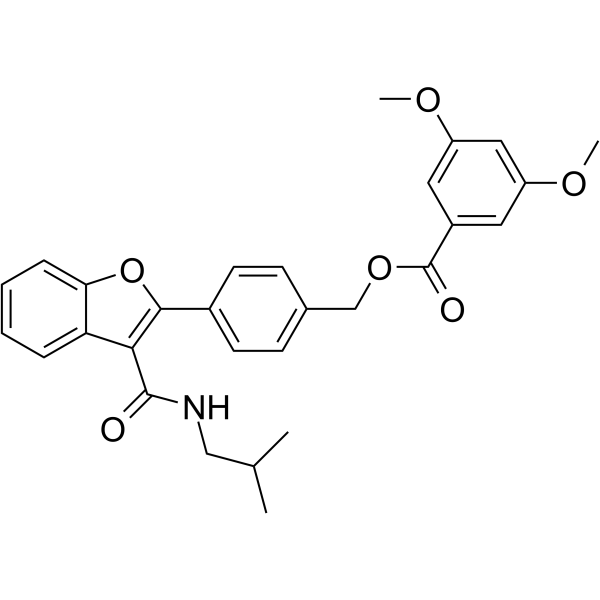
- HY-W592871
-
|
10-HDA
|
mTOR
|
Cardiovascular Disease
Inflammation/Immunology
Cancer
|
|
10-Hydroxy-2-decenoic acid (10-HDA) is the major lipid component of royal jelly produced by honeybees. 10-Hydroxy-2-decenoic acid has several health-beneficial effects in mammals, such as antitumor activity, anti-inflammatory activity, and antiangiogenic activity. 10-Hydroxy-2-decenoic acid also extends the lifespan of C. elegans .
|
-
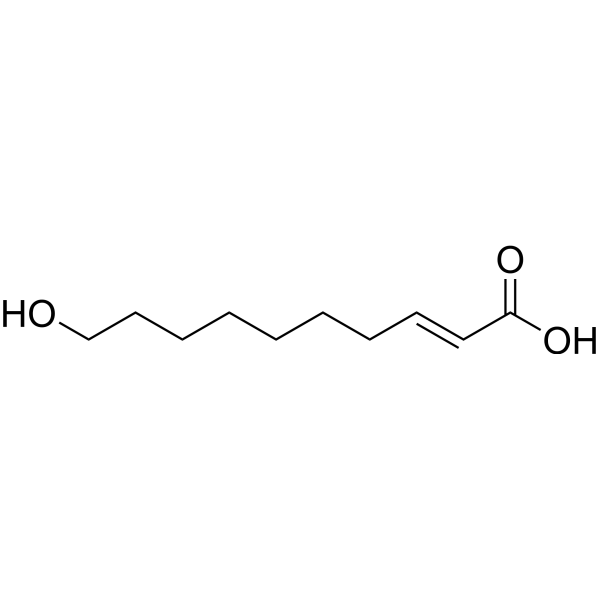
- HY-N2329
-
|
Piplartine
|
ERK
Reactive Oxygen Species
Autophagy
Apoptosis
Bacterial
Ferroptosis
|
Infection
Cardiovascular Disease
Cancer
|
|
Piperlongumine is a alkaloid , possesses ant-inflammatory, antibacterial, antiangiogenic, antioxidant, antitumor, and antidiabetic activities . Piperlongumine induces ROS, and induces apoptosis in cancer cell lines . Piperlongumine shows anti-cardiac fibrosis activity, suppresses myofibroblast transformation via suppression of the ERK1/2 signaling pathway. Piperlongumin could be used in the study of migrasome .
|
-
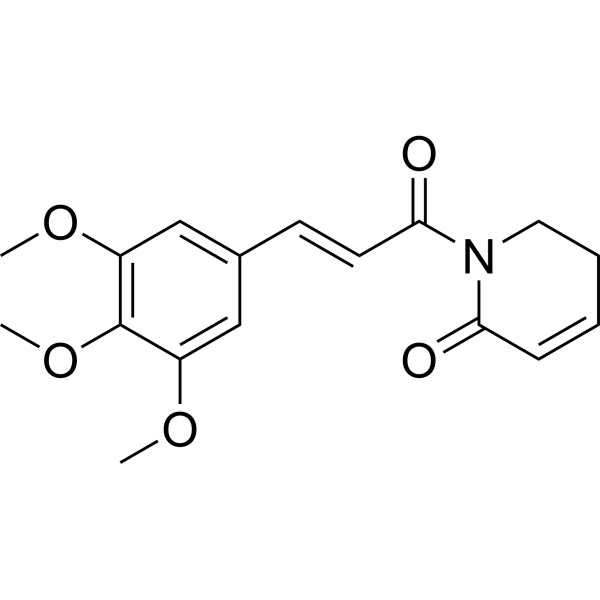
- HY-10330
-
|
SU11654; PHA 291639E
|
PDGFR
VEGFR
c-Kit
|
Cancer
|
|
Toceranib phosphate (SU11654 phosphate) is an orally active receptor tyrosine kinase (RTK) inhibitor, and it potently inhibits PDGFR, VEGFR, and Kit with Kis of 5 and 6 nM for PDGFRβ and Flk-1/KDR, respectively. Toceranib phosphate (SU11654 phosphate) has antitumor and antiangiogenic activity, and used in the treatment of canine mast cell tumors .
|
-

- HY-10330A
-
|
SU11654 phosphate; PHA 291639E phosphate
|
PDGFR
VEGFR
c-Kit
|
Cancer
|
|
Toceranib phosphate (SU11654 phosphate) is an orally active receptor tyrosine kinase (RTK) inhibitor, and it potently inhibits PDGFR, VEGFR, and Kit with Kis of 5 and 6 nM for PDGFRβ and Flk-1/KDR, respectively. Toceranib phosphate (SU11654 phosphate) has antitumor and antiangiogenic activity, and used in the treatment of canine mast cell tumors .
|
-

- HY-N0005S
-
-
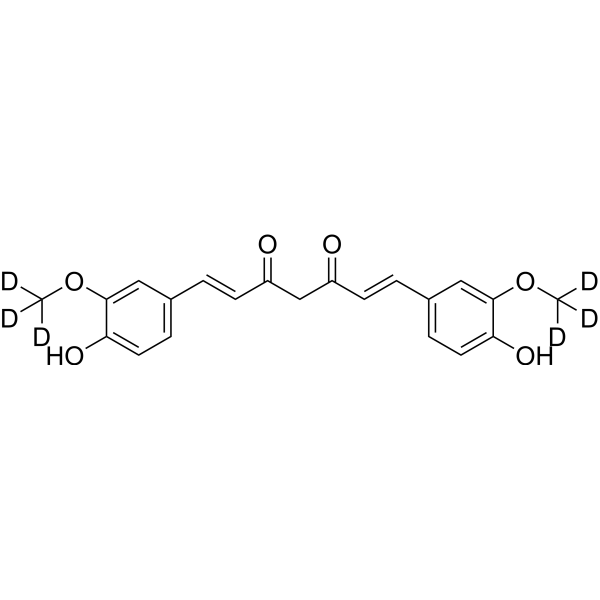
- HY-10331
-
|
BAY 73-4506
|
VEGFR
Autophagy
PDGFR
Raf
RET
c-Kit
FGFR
Tie
|
Cancer
|
|
Regorafenib (BAY 73-4506) is an orally active and potent multi-targeted receptor tyrosine kinase inhibitor, with IC50 values of 13/4.2/46, 22, 7, 1.5 and 2.5 nM for VEGFR1/2/3, PDGFRβ, Kit, RET and Raf-1, respectively. Regorafenib shows very robust antitumor and antiangiogenic activity .
|
-
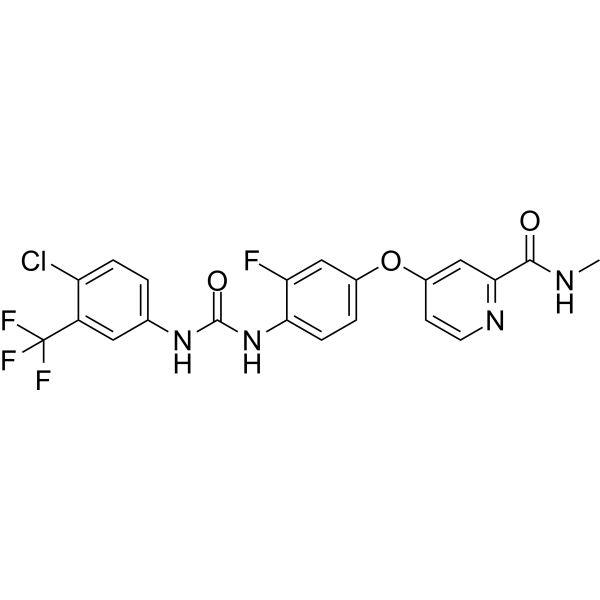
- HY-10331A
-
|
BAY 73-4506 monohydrate
|
VEGFR
Autophagy
PDGFR
Raf
RET
FGFR
c-Kit
Tie
|
Cancer
|
|
Regorafenib (BAY 73-4506) monohydrate is an orally active and potent multi-targeted receptor tyrosine kinase inhibitor, with IC50 values of 13/4.2/46, 22, 7, 1.5 and 2.5 nM for VEGFR1/2/3, PDGFRβ, Kit, RET and Raf-1, respectively. Regorafenib monohydrate shows very robust antitumor and antiangiogenic activity .
|
-
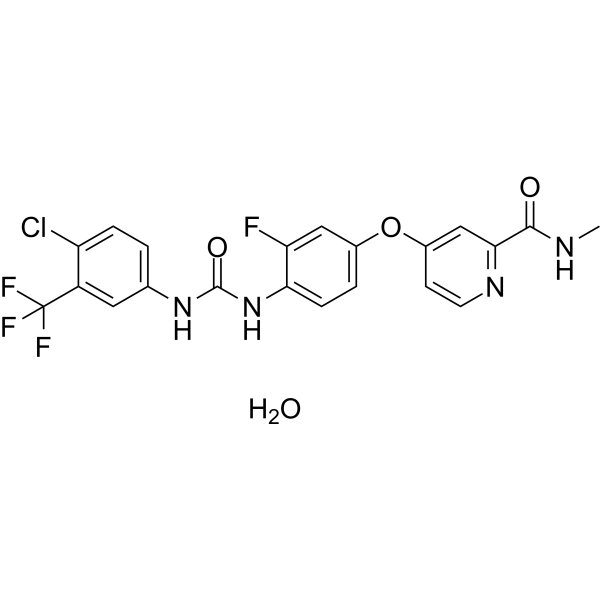
- HY-133016
-
|
|
MetAP
|
Cardiovascular Disease
Cancer
|
|
M8891 is an orally active, reversible and brain penetrant Methionine Aminopeptidase-2 (MetAP-2) inhibitor with an IC50 of 54 nM and a Ki of 4.33 nM. M8891 does not inhibit MetAP-1 (IC50>10 µM) . M8891 inhibits growth of primary endothelial cells as well as tumor cells and demonstrates antiangiogenic and antitumoral activity .
|
-
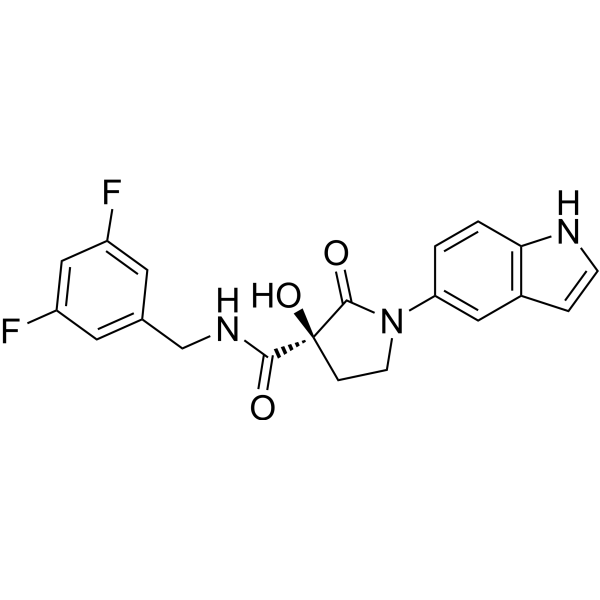
- HY-10331B
-
|
BAY 73-4506 mesylate
|
VEGFR
PDGFR
RET
Raf
c-Kit
FGFR
Autophagy
Tie
|
Cancer
|
|
Regorafenib (BAY 73-4506) mesylate is an orally active and potent multi-targeted receptor tyrosine kinase inhibitor, with IC50 values of 13/4.2/46, 22, 7, 1.5 and 2.5 nM for VEGFR1/2/3, PDGFRβ, Kit, RET and Raf-1, respectively. Regorafenib mesylate shows very robust antitumor and antiangiogenic activity .
|
-
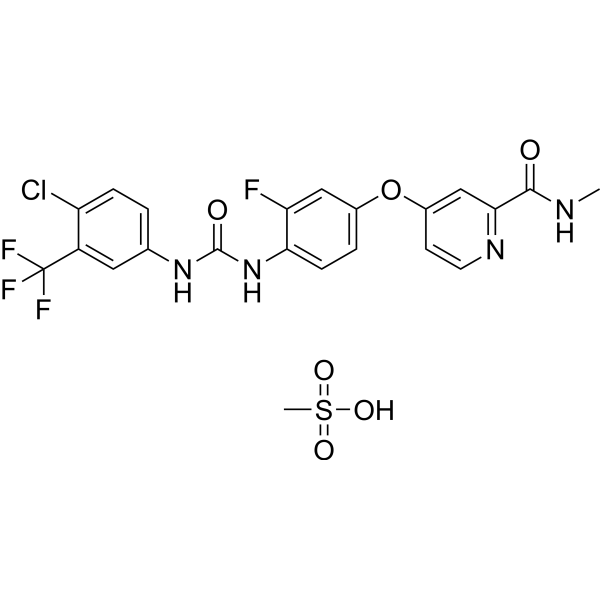
- HY-15995
-
|
TubA
|
ADC Cytotoxin
Antibiotic
Microtubule/Tubulin
|
Cancer
|
|
Tubulysin A (TubA) is an anticancer and antiangiogenic agent with anti-microtubule, anti-mitosis and anti-proliferative activity against a variety of cancer cells with IC50 values in the pmol range. It can induce apoptosis of cancer cells and has no effect on normal cells. Tubulysins are a group of potent cytotoxins consisting of nine members (A-I). Tubulysin A can synthesize ADC as ADC Cytotoxin< b>ADC Cytotoxin .
|
-
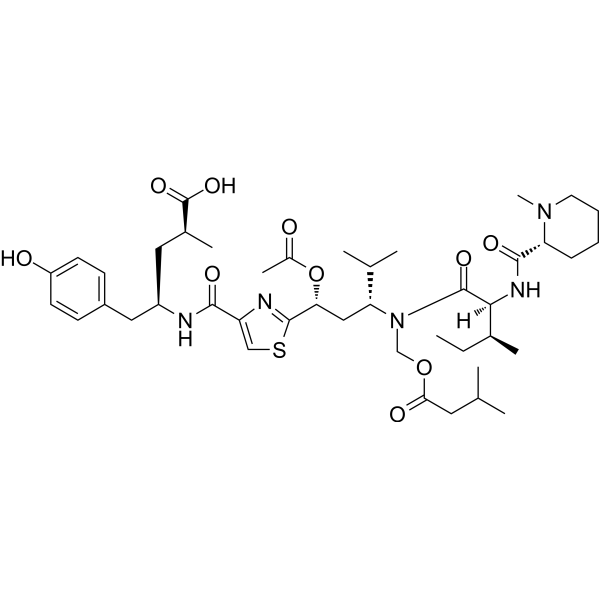
- HY-10330S
-
|
|
Isotope-Labeled Compounds
PDGFR
VEGFR
c-Kit
|
Cancer
|
|
Toceranib-d8 is the deuterium labeled Toceranib. Toceranib (SU11654) is an orally active receptor tyrosine kinase (RTK) inhibitor, and it potently inhibits PDGFR, VEGFR, and Kit with Kis of 5 and 6 nM for PDGFRβ and Flk-1/KDR, respectively. Toceranib (SU11654) has antitumor and antiangiogenic activity, and used in the treatment of canine mast cell tumors[1][2].
|
-
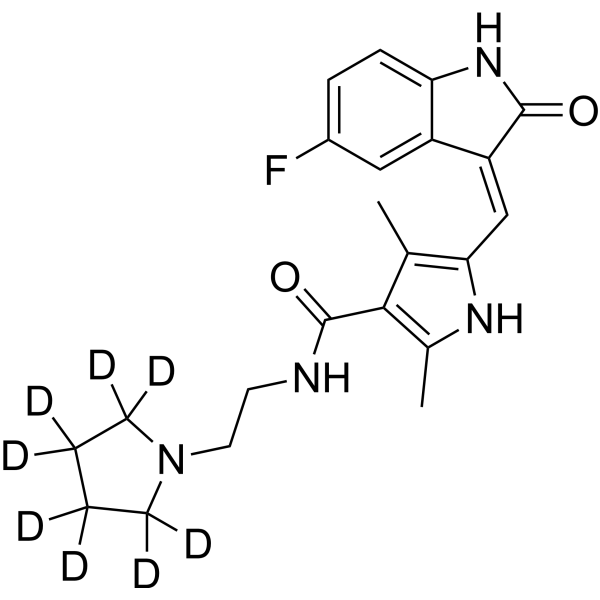
- HY-N2132
-
|
Flavokavain B
|
Apoptosis
|
Cancer
|
|
Flavokawain B (Flavokavain B) is a chalcone isolated from the root extracts of kava-kava plant and a potent apoptosis inducer for inhibiting the growth of various cancer cell lines. Flavokawain B (Flavokavain B) shows strong antiangiogenic activity. Flavokawain B (Flavokavain B) inhibits human brain endothelial cell (HUVEC) migration and tube formation with very low and non-toxic concentrations .
|
-
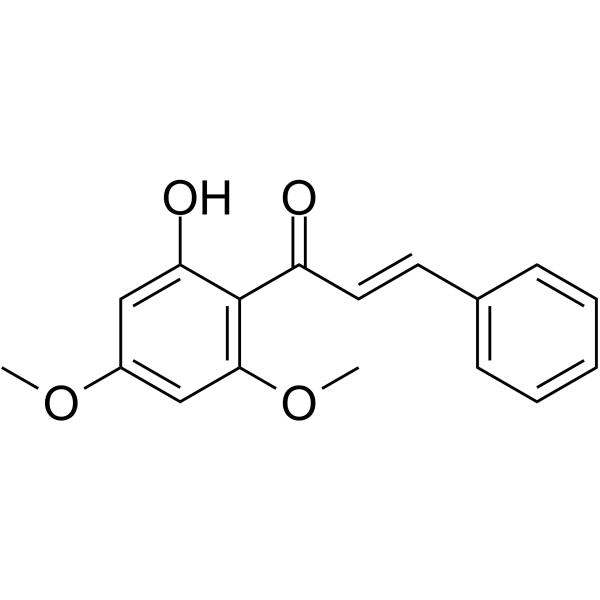
- HY-P99333
-
|
M200; Eos 200-4
|
Integrin
|
Cardiovascular Disease
Cancer
|
|
Volociximab (M200) is a chimeric human/murine IgG4 antibody IIA1 targeting integrin α5β1 (EC50=0.2 nM). Integrin α5β1 is a major fibronectin receptor involved in angiogenesis. Volociximab has antiangiogenic and antitumor activities and inhibits the proliferation of human umbilical vein vascular endothelial cells (HUVECs) .
|
-
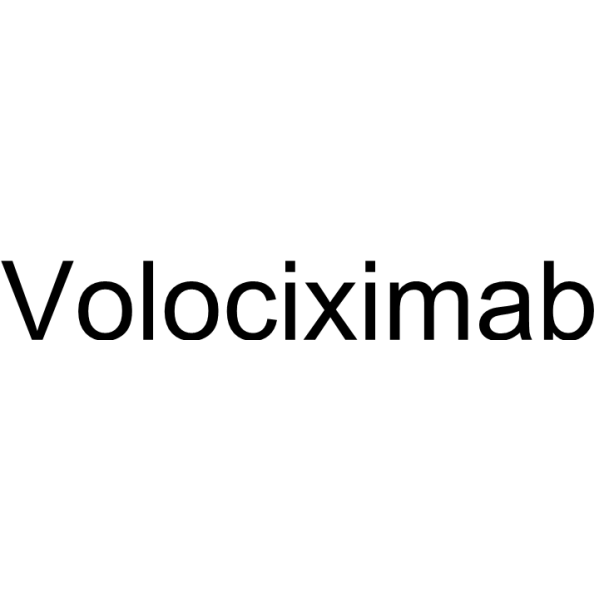
- HY-13016A
-
|
XL184 hydrochloride; BMS-907351 hydrochloride
|
VEGFR
c-Met/HGFR
c-Kit
TAM Receptor
FLT3
Apoptosis
|
Cancer
|
|
Cabozantinib hydrochloride is a potent and orally active inhibitor of VEGFR2 and MET, with IC50 values of 0.035 and 1.3 nM, respectively. Cabozantinib hydrochloride displays strong inhibition of KIT, RET, AXL, TIE2, and FLT3 (IC50=4.6, 5.2, 7, 14.3, and 11.3 nM, respectively). Cabozantinib hydrochloride shows antiangiogenic activity. Cabozantinib hydrochloride disrupts tumor vasculature and promotes tumor and endothelial cell apoptosis .
|
-
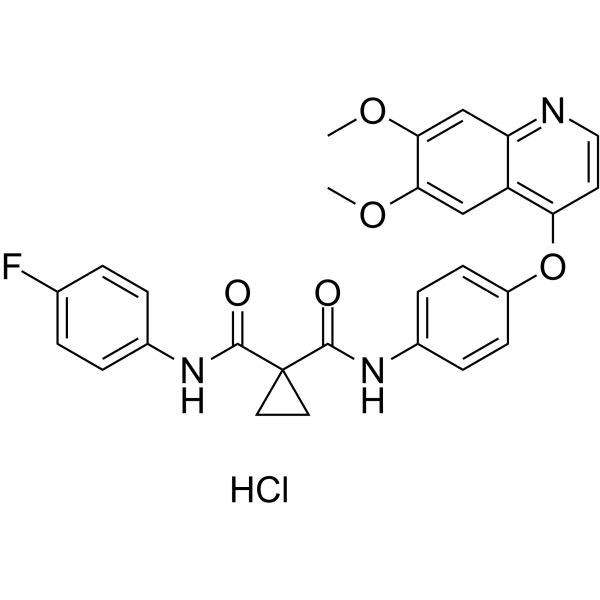
- HY-13016
-
|
XL184; BMS-907351
|
VEGFR
c-Met/HGFR
c-Kit
TAM Receptor
FLT3
Apoptosis
|
Cancer
|
|
Cabozantinib is a potent and orally active inhibitor of VEGFR2 and MET, with IC50 values of 0.035, and 1.3 nM, respectively. Cabozantinib displays strong inhibition of KIT, RET, AXL, TIE2, and FLT3 (IC50=4.6, 5.2, 7, 14.3, and 11.3 nM, respectively). Cabozantinib shows antiangiogenic activity. Cabozantinib disrupts tumor vasculature and promotes tumor and endothelial cell apoptosis .
|
-
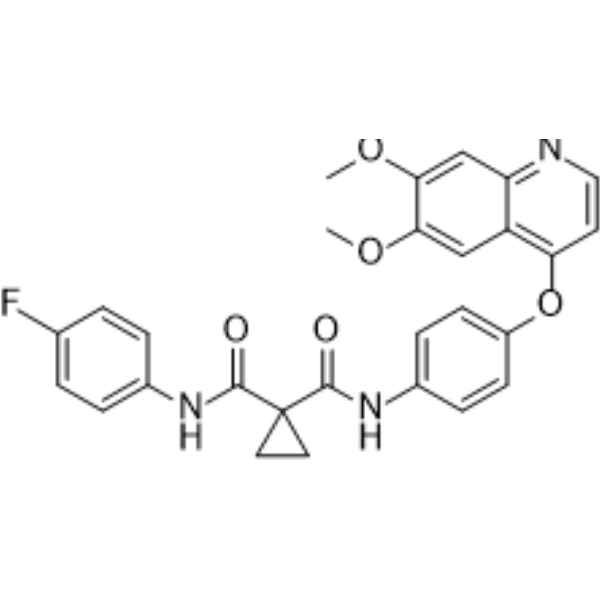
- HY-W011266
-
|
|
PDGFR
|
Cancer
|
|
JNJ-10198409 is a relatively selective, orally active, and ATP competitive PDGF-RTK (platelet-derived growth factor receptor tyrosine kinase) inhibitor (IC50=2 nM). It is a dual-mechanism, antiangiogenic, and tumor cell antiproliferative agent. JNJ-10198409 has good activity against PDGFR-β kinase (IC50=4.2 nM) and PDGFR-α kinase (IC50=45 nM) .
|
-

- HY-D0803
-
|
|
Apoptosis
VEGFR
PI3K
Akt
|
Infection
Cardiovascular Disease
Neurological Disease
Inflammation/Immunology
Cancer
|
|
Thymoquinone is an orally active natural product isolated from N. sativa Thymoquinone down-regulates the VEGFR2-PI3K-Akt pathway. Thymoquinone has antioxidant, anti-inflammatory, anticancer, antiviral, anticonvulsant, antifungal, antiviral, antiangiogenic activity and hepatoprotective effects. Thymoquinone can be used to study Alzheimer's disease, cancer, cardiovascular disease, infectious disease and inflammation .
|
-

- HY-N0005
-
Curcumin
Maximum Cited Publications
62 Publications Verification
Diferuloylmethane; Natural Yellow 3; Turmeric yellow
|
Histone Acetyltransferase
Epigenetic Reader Domain
Keap1-Nrf2
Autophagy
Mitophagy
Influenza Virus
Ferroptosis
|
Cancer
|
|
Curcumin (Diferuloylmethane), a natural phenolic compound, is a p300/CREB-binding protein-specific inhibitor of acetyltransferase, represses the acetylation of histone/nonhistone proteins and histone acetyltransferase-dependent chromatin transcription. Curcumin shows inhibitory effects on NF-κB and MAPKs, and has diverse pharmacologic effects including anti-inflammatory, antioxidant, antiproliferative and antiangiogenic activities. Curcumin induces stabilization of Nrf2 protein through Keap1 cysteine modification.
|
-

- HY-14571
-
E7820
4 Publications Verification
ER68203-00
|
Molecular Glues
Integrin
|
Cancer
|
|
E7820 (ER68203-00), an orally active aromatic sulfonamide derivative, is a unique angiogenesis inhibitor suppressing an expression of integrin alpha2 subunit on endothelium. E7820 inhibits rat aorta angiogenesis with an IC50 of 0.11 μg/ml. E7820 modulates α-1, α-2, α-3, and α-5 integrin mRNA expression. Antiangiogenic and antitumor activity .
|
-

- HY-19754
-
|
|
|
|
|
CRA-026440 is a potent, broad-spectrum HDAC inhibitor. The Ki values against recombinant HDAC isoenzymes HDAC1, HDAC2, HDAC3, HDAC6, HDAC8, and HDAC10 are 4, 14, 11, 15, 7, and 20 nM respectively. CRA-026440 shows antitumor and antiangiogenic activities . CRA-026440 is a click chemistry reagent, it contains an Alkyne group and can undergo copper-catalyzed azide-alkyne cycloaddition (CuAAc) with molecules containing Azide groups.
|
-

- HY-19754A
-
|
|
HDAC
Apoptosis
|
Cancer
|
|
CRA-026440 hydrochloride is a potent, broad-spectrum HDAC (HDAC) inhibitor. The Ki values against recombinant HDAC isoenzymes HDAC1, HDAC2, HDAC3, HDAC6, HDAC8, and HDAC10 are 4 nM, 14 nM, 11 nM, 15 nM, 7 nM, and 20 nM respectively. CRA-026440 hydrochloride shows antitumor and antiangiogenic activities . CRA-026440 (hydrochloride) is a click chemistry reagent, it contains an Alkyne group and can undergo copper-catalyzed azide-alkyne cycloaddition (CuAAc) with molecules containing Azide groups.
|
-
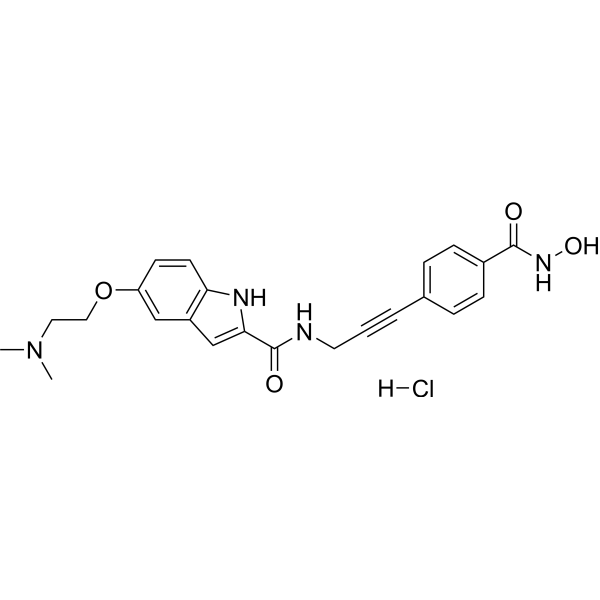
- HY-12403A
-
|
TXA127 acetate; Angiotensin (1-7) (acetate); Ang-(1-7) (acetate)
|
Angiotensin Receptor
Angiotensin-converting Enzyme (ACE)
Endogenous Metabolite
|
Cardiovascular Disease
Inflammation/Immunology
Endocrinology
|
|
Angiotensin 1-7 (Ang-(1-7)) acetate is an endogenous heptapeptide from the renin-angiotensin system (RAS) with a cardioprotective role due to its anti-inflammatory and anti-fibrotic activities in cardiac cells. Angiotensin 1-7 acetate inhibits purified canine ACE activity (IC50=0.65 μM). Angiotensin 1-7 acetate acts as a local synergistic modulator of kinin-induced vasodilation by inhibiting ACE and releasing nitric oxide. Angiotensin 1-7 acetate blocks Ang II-induced smooth muscle cell proliferation and hypertrophy and shows antiangiogenic and growth-inhibitory effects on the endothelium .
|
-
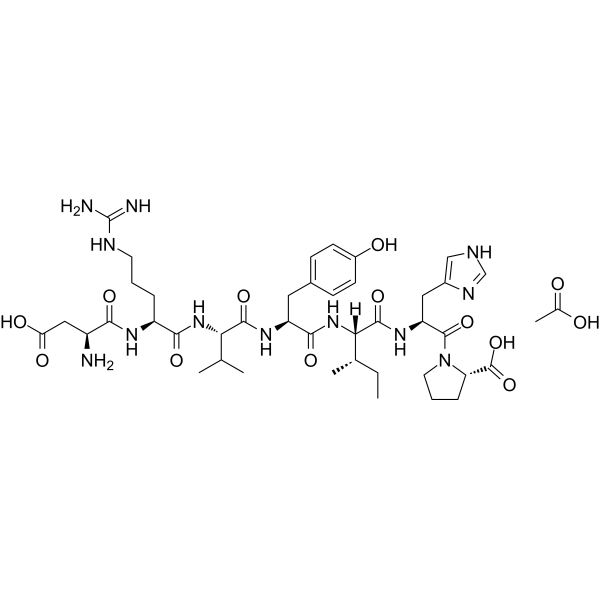
- HY-12403
-
|
TXA127; Angiotensin (1-7); Ang-(1-7)
|
Angiotensin Receptor
Angiotensin-converting Enzyme (ACE)
Endogenous Metabolite
|
Cardiovascular Disease
Inflammation/Immunology
Endocrinology
|
|
Angiotensin 1-7 (Ang-(1-7)) is an endogenous heptapeptide from the renin-angiotensin system (RAS) with a cardioprotective role due to its anti-inflammatory and anti-fibrotic activities in cardiac cells. Angiotensin 1-7 inhibits purified canine ACE activity (IC50=0.65 μM). Angiotensin 1-7 acts as a local synergistic modulator of kinin-induced vasodilation by inhibiting ACE and releasing nitric oxide. Angiotensin 1-7 blocks Ang II-induced smooth muscle cell proliferation and hypertrophy and shows antiangiogenic and growth-inhibitory effects on the endothelium. Angiotensin 1-7 shows anti-inflammatory activity .
|
-

- HY-W800162
-
|
|
VEGFR
|
Cancer
|
|
VEGFR-2-IN-37 (compound 12) is an inhibitor of VEGFR-2. The inhibition rate at 200 μM was approximately 56.9 μM. VEGFR-2-IN-37 is a potential inhibitor of human umbilical vein endothelial cell (HUVEC) proliferation .
|
-

| Cat. No. |
Product Name |
Type |
-
- HY-W016412
-
|
CoQ0
|
Biochemical Assay Reagents
|
|
Coenzyme Q0 (CoQ0) is a potent, oral active ubiquinone compound can be derived from Antrodia cinnamomea. Coenzyme Q0 induces apoptosis and autophagy, suppresses of HER-2/AKT/mTOR signaling to potentiate the apoptosis and autophagy mechanisms. Coenzyme Q0 regulates NFκB/AP-1 activation and enhances Nrf2 stabilization in attenuation of inflammation and redox imbalance. Coenzyme Q0 has anti-angiogenic activity through downregulation of MMP-9/NF-κB and upregulation of HO-1 signaling .
|
| Cat. No. |
Product Name |
Target |
Research Area |
-
- HY-P2284
-
|
|
Peptides
|
Cancer
|
|
AD 01, a 24 amino acid peptide of FKBPL (FK506-binding protein like), possesses potent anti-angiogenic activity. AD 01 bind to the CD44 receptor and inhibit tumour cell migration in a CD44 dependant manner .
|
-
- HY-P1415A
-
-
- HY-P1798
-
|
|
Peptides
|
Cardiovascular Disease
|
|
Platelet Factor 4 (58-70), human, a peptide based on the amino acid sequence corresponding to residues 58-70 of platelet factor-4 (PF-4), contains the major heparin-binding domain, which is not sufficient for full antiangiogenic activity .
|
-
- HY-12403A
-
|
TXA127 acetate; Angiotensin (1-7) (acetate); Ang-(1-7) (acetate)
|
Angiotensin Receptor
Angiotensin-converting Enzyme (ACE)
Endogenous Metabolite
|
Cardiovascular Disease
Inflammation/Immunology
Endocrinology
|
|
Angiotensin 1-7 (Ang-(1-7)) acetate is an endogenous heptapeptide from the renin-angiotensin system (RAS) with a cardioprotective role due to its anti-inflammatory and anti-fibrotic activities in cardiac cells. Angiotensin 1-7 acetate inhibits purified canine ACE activity (IC50=0.65 μM). Angiotensin 1-7 acetate acts as a local synergistic modulator of kinin-induced vasodilation by inhibiting ACE and releasing nitric oxide. Angiotensin 1-7 acetate blocks Ang II-induced smooth muscle cell proliferation and hypertrophy and shows antiangiogenic and growth-inhibitory effects on the endothelium .
|
-
- HY-P1415
-
-
- HY-12403
-
Talfirastide
Maximum Cited Publications
9 Publications Verification
TXA127; Angiotensin (1-7); Ang-(1-7)
|
Angiotensin Receptor
Angiotensin-converting Enzyme (ACE)
Endogenous Metabolite
|
Cardiovascular Disease
Inflammation/Immunology
Endocrinology
|
|
Angiotensin 1-7 (Ang-(1-7)) is an endogenous heptapeptide from the renin-angiotensin system (RAS) with a cardioprotective role due to its anti-inflammatory and anti-fibrotic activities in cardiac cells. Angiotensin 1-7 inhibits purified canine ACE activity (IC50=0.65 μM). Angiotensin 1-7 acts as a local synergistic modulator of kinin-induced vasodilation by inhibiting ACE and releasing nitric oxide. Angiotensin 1-7 blocks Ang II-induced smooth muscle cell proliferation and hypertrophy and shows antiangiogenic and growth-inhibitory effects on the endothelium. Angiotensin 1-7 shows anti-inflammatory activity .
|
| Cat. No. |
Product Name |
Target |
Research Area |
-
- HY-P99386
-
|
MNRP-1685A
|
Complement System
|
Cancer
|
|
Vesencumab (MNRP-1685A) is IG1 antibody against neuropilin-1 (NRP-1). Vesencumab binds to NRP-1 and prevents the subsequent coupling of NRP-1 to VEGFR-2. Vesencumab has anti-angiogenic and anti-neoplastic activities. Vesencumab can be used in the research of metastatic solid tumors, including ovarian cancer .
|
-
- HY-P99768
-
|
TTAC-0001
|
VEGFR
|
Cancer
|
|
Olinvacimab (TTAC-0001) is a fully human anti-VEGFR2 monoclonal antibody. Olinvacimab inhibits VEGF binds to KDR with a Kd value of 0.23 nM. Olinvacimab has antiangiogenic activity. Olinvacimab can be used for the research of recurrent glioblastoma and breast cancer .
|
-
- HY-P99333
-
|
M200; Eos 200-4
|
Integrin
|
Cardiovascular Disease
Cancer
|
|
Volociximab (M200) is a chimeric human/murine IgG4 antibody IIA1 targeting integrin α5β1 (EC50=0.2 nM). Integrin α5β1 is a major fibronectin receptor involved in angiogenesis. Volociximab has antiangiogenic and antitumor activities and inhibits the proliferation of human umbilical vein vascular endothelial cells (HUVECs) .
|
| Cat. No. |
Product Name |
Category |
Target |
Chemical Structure |
-
- HY-N0793
-
-

-
- HY-N0205
-
-

-
- HY-N6258
-
-

-
- HY-136901
-
-

-
- HY-N0793A
-
-

-
- HY-129325
-
-

-
- HY-N1067
-
-

-
- HY-W008859
-
-

-
- HY-N0923
-
-

-
- HY-19827
-
-

-
- HY-107818
-
-

-
- HY-N2533
-
-

-
- HY-N6924
-
-

-
- HY-N0615
-
-

-
- HY-N0234
-
-

-
- HY-N4226
-
|
|
other families
Microorganisms
Classification of Application Fields
Ketones, Aldehydes, Acids
Source classification
Plants
Disease Research Fields
Cancer
|
AP-1
|
|
1-Methyl-6-oxo-1,6-dihydropyridine-3-carboxylic acid is from Cordyceps bassiana, which is one of Cordyceps species with anti-oxidative, anti-cancer, anti-inflammatory, anti-diabetic, anti-obesity, anti-angiogenic, and anti-nociceptive activities. 1-Methyl-6-oxo-1,6-dihydropyridine-3-carboxylic acid targets to block AP-1-mediated luciferase activity, implying it has an anti-inflammatory function .
|
-

-
- HY-N9396
-
-

-
- HY-N4094
-
-

-
- HY-121382
-
-

-
- HY-N5074
-
-

-
- HY-N2732
-
-

-
- HY-N8178
-
-

-
- HY-N0003
-
-

-
- HY-N8342
-
-

-
- HY-108486
-
-

-
- HY-W592871
-
|
10-HDA
|
Structural Classification
Animals
Ketones, Aldehydes, Acids
Source classification
|
mTOR
|
|
10-Hydroxy-2-decenoic acid (10-HDA) is the major lipid component of royal jelly produced by honeybees. 10-Hydroxy-2-decenoic acid has several health-beneficial effects in mammals, such as antitumor activity, anti-inflammatory activity, and antiangiogenic activity. 10-Hydroxy-2-decenoic acid also extends the lifespan of C. elegans .
|
-

-
- HY-N2329
-
-

-
- HY-N2132
-
-

-
- HY-D0803
-
|
|
Quinones
Structural Classification
Classification of Application Fields
Nigella sativa L.
Ranunculaceae
Benzene Quinones
Plants
Inflammation/Immunology
Disease Research Fields
|
Apoptosis
VEGFR
PI3K
Akt
|
|
Thymoquinone is an orally active natural product isolated from N. sativa Thymoquinone down-regulates the VEGFR2-PI3K-Akt pathway. Thymoquinone has antioxidant, anti-inflammatory, anticancer, antiviral, anticonvulsant, antifungal, antiviral, antiangiogenic activity and hepatoprotective effects. Thymoquinone can be used to study Alzheimer's disease, cancer, cardiovascular disease, infectious disease and inflammation .
|
-

-
- HY-N0005
-
-

-
- HY-12403A
-
-

-
- HY-12403
-
-

| Cat. No. |
Product Name |
Chemical Structure |
-
- HY-B0965AS
-
|
|
|
Thioridazine-d3 (hydrochloride) is the deuterium labeled Thioridazine. Thioridazine, an antagonist of the dopamine receptor D2 family proteins, exhibits potent anti-psychotic and anti-anxiety activities. Thioridazine is also a potent inhibitor of PI3K-Akt-mTOR signaling pathways with anti-angiogenic effect. Thioridazine shows antiproliferative and apoptosis induction effects in various types of cancer cells, with specificity on targeting cancer stem cells (CSCs)[1][2][3][4].
|
-

-
- HY-N0005S
-
|
|
|
Curcumin-d6is a deuterium labeled Curcumin (Turmeric yellow). Curcumin (Turmeric yellow) is a natural phenolic compound with diverse pharmacologic effects including anti-inflammatory, antioxidant, antiproliferative and antiangiogenic activities. Curcumin is an inhibitor of p300 histone acetylatransferase (HATs) and also shows inhibitory effects on NF-κB and MAPKs.
|
-

-
- HY-12289S
-
|
|
|
Defactinib-d6 is a deuterium labeled Defactinib (HY-12289). Defactinib is a novel FAK inhibitor with potential antiangiogenic and antineoplastic activities .
|
-

-
- HY-10330S
-
|
|
|
Toceranib-d8 is the deuterium labeled Toceranib. Toceranib (SU11654) is an orally active receptor tyrosine kinase (RTK) inhibitor, and it potently inhibits PDGFR, VEGFR, and Kit with Kis of 5 and 6 nM for PDGFRβ and Flk-1/KDR, respectively. Toceranib (SU11654) has antitumor and antiangiogenic activity, and used in the treatment of canine mast cell tumors[1][2].
|
-

Your information is safe with us. * Required Fields.
Inquiry Information
- Product Name:
- Cat. No.:
- Quantity:
- MCE Japan Authorized Agent:




































































































